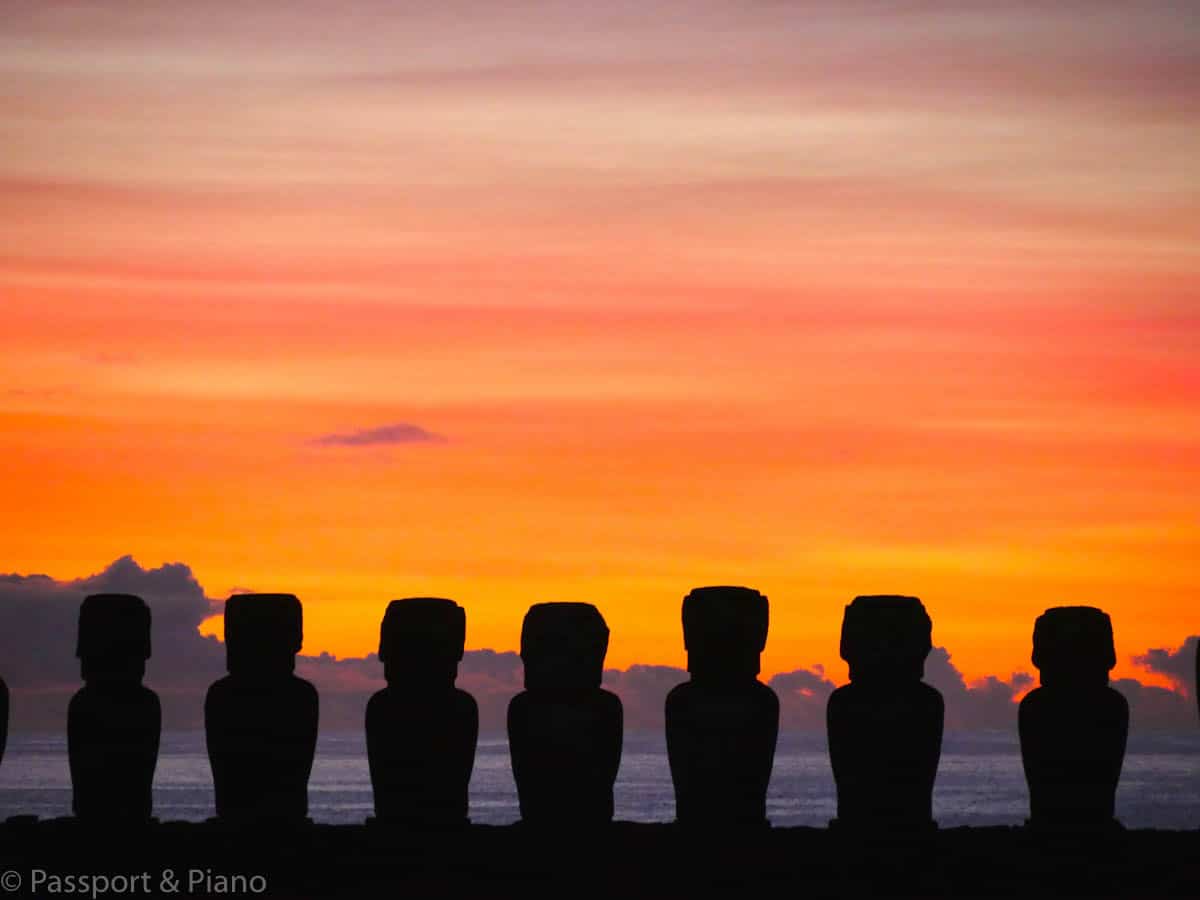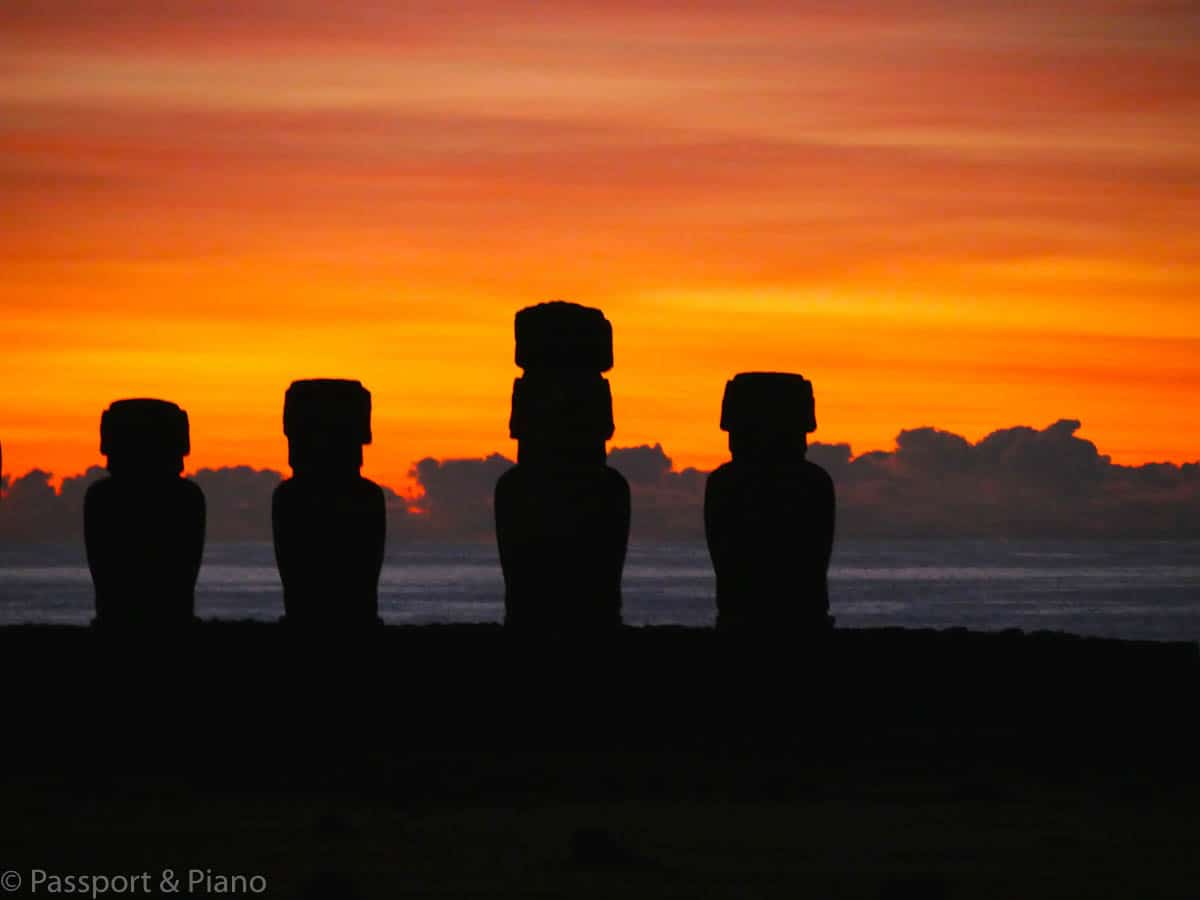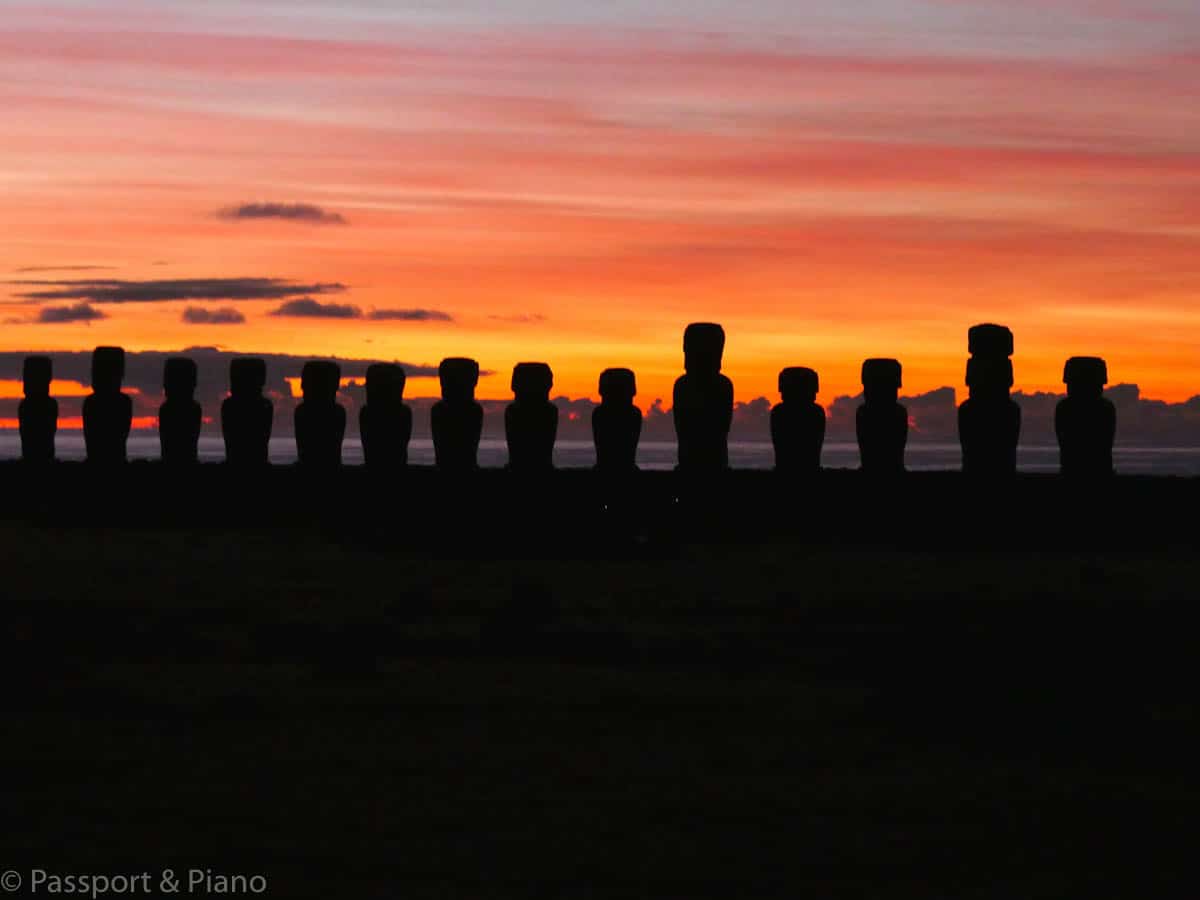Easter Island Chile is one of the remotest islands you can visit in the world. To make the most of your Easter Island itinerary we’ve put together this Easter Island travel guide.
We are sure that it will act as your complete companion when you visit Easter Island.
This article may contain compensated links. Please read my disclaimer policy for more info.
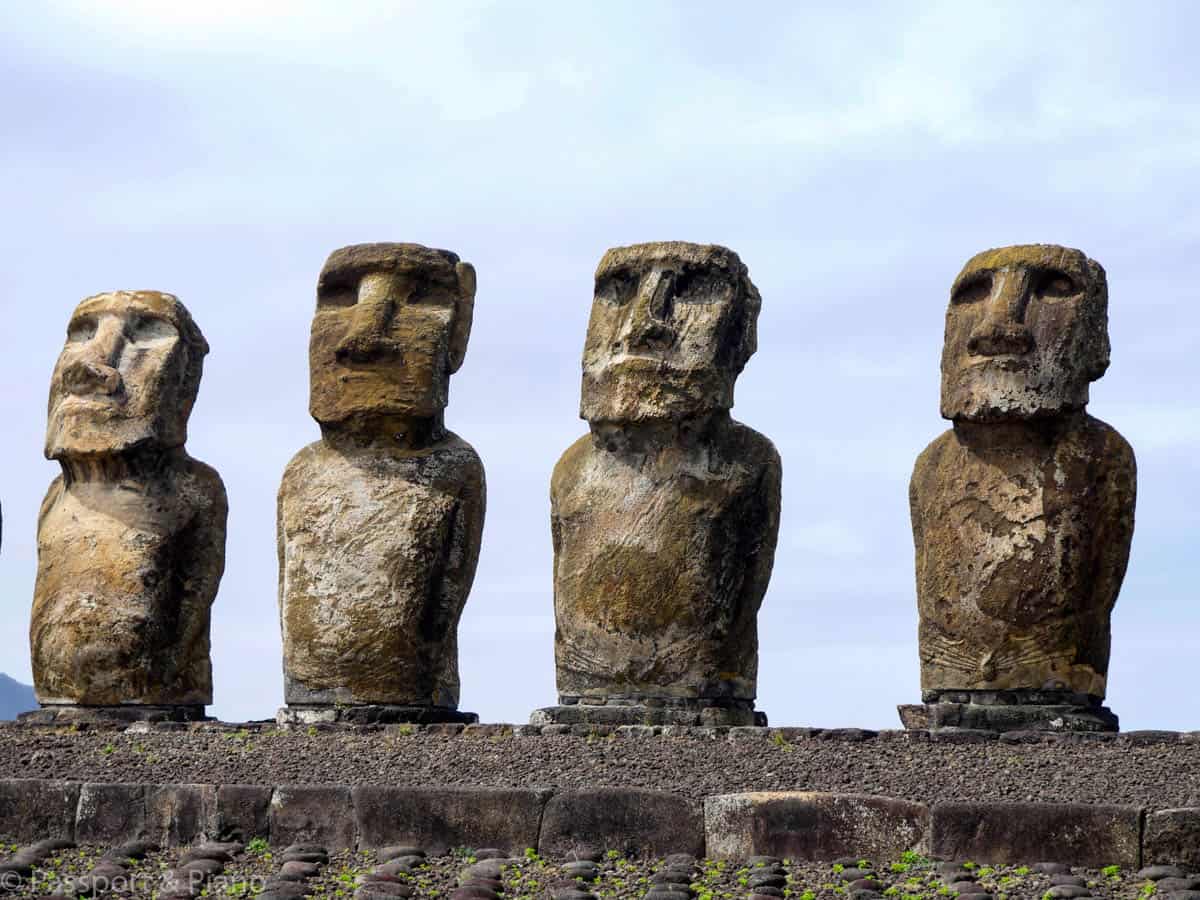
Why take an Easter Island trip?
There are few places as magical and mysterious in the world as this tiny island. Of course, the main reason people travel here is to see the famous easter island heads.
Exploring the splendours of the Unesco heritage site, Rapa Nui National park is also one of Easter Island main attractions. However, there are several other things to do on Easter Island that make an Easter Island holiday genuinely unique.
There are some spectacular caves to venture into where you can find magnificent rock paintings. You can delve into and learn about the rich cultural heritage, explore remote spots, plus there are a plethora of archaeological sites to discover more about Easter Islands mysteries.
Aside from easter island history, you can learn to scuba dive, hike to some of the worlds remotest spots or relax on one of Easter islands beaches. Easter Island is, without a doubt worth visiting on your South America trip.
How to get to Easter Island
Travel to easter island is time-consuming, and it’s best to combine trips to Easter Island with a vacation in Chile. Lan operates Easter island flights, and for much of the year, there’s only one flight per day.
If you are looking for other places to visit as well as Easter Island why not check out our posts on South America here?
Flights to Easter Island depart from Santiago, and the journey takes 6 hours hence you’ll need to arrive in the capital of Chile at least one day before departure.
The only alternative way, if Santiago to Easter Island doesn’t suite is to fly from Tahiti. However, flights on this route are less frequent.
When planning easter island holidays, it’s essential to book everything in advance as the number of visitors is limited.
TIP –While most tourists know the island as Easter Island, its real name is Isla de Pascua. Hence the easter island airport code is IPC when searching for flights.
When visiting Easter Island, the locals will love you more if you refer to it by its correct name.
Arrival at Easter Island airport
The airport is the worlds most remote, and as you can imagine, it’s unlike most other airports. It only opens its doors when a flight is due to arrive or depart. Hence, everyone inside is either embarking or disembarking the same aircraft.

As such security is much less informal than you’ll be used to and its unique charm gives a taste of what life is like on this island.
National Park ticket
On arrival, you first have to pay your Rapa Nui National Park at the desk. For foreign visitors, it’s 80 USD dollars. Bring cash as its easier and quicker to make the payment.
Getting to your Easter Island accommodation
There is no public transport on the island so all hosts whether from Easter Island hotels or Airbnb’s will collect you from the airport.
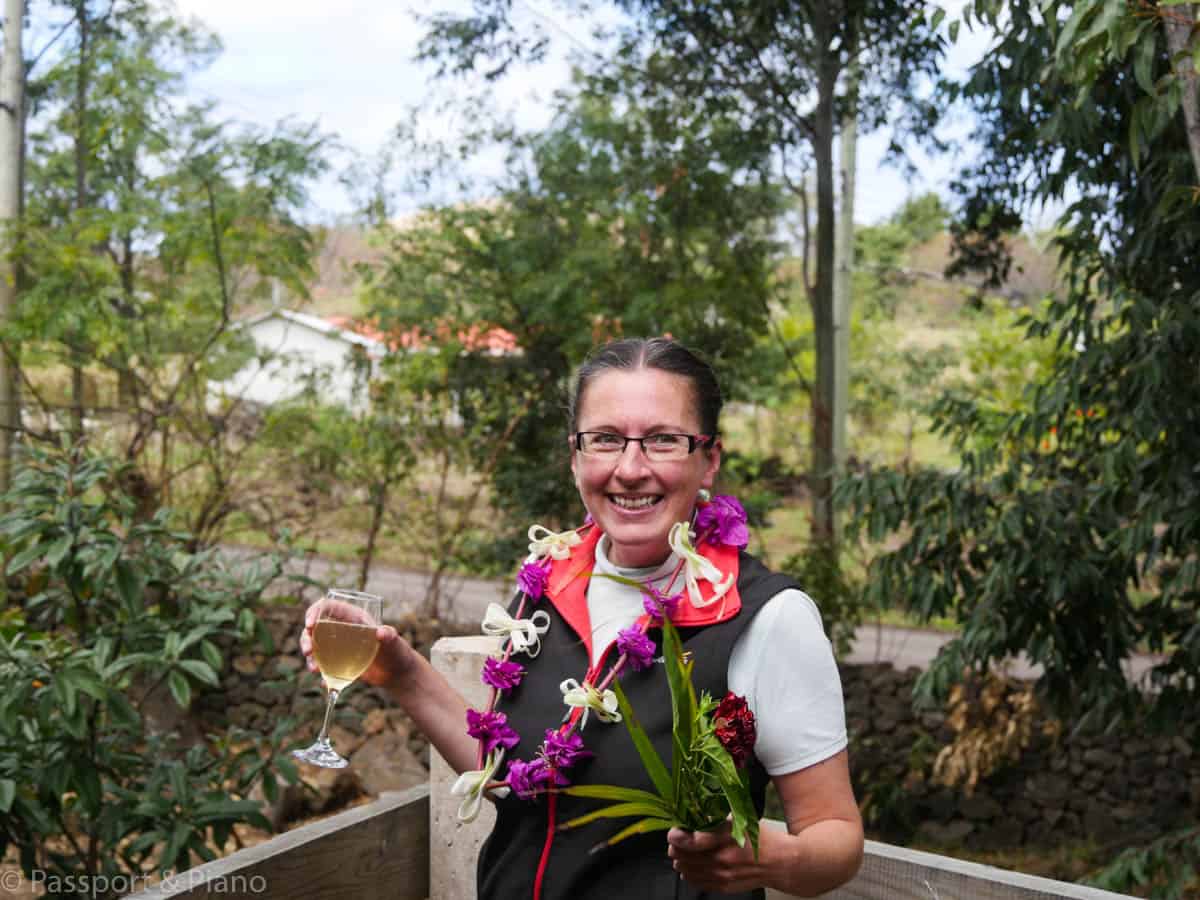
Most will be there to greet you with a beautiful garland of flowers, and they’ll make you feel welcome from the moment you arrive.
Easter Island car rental
Having a car is advisable if you want to explore the island, although you can hire bikes or book tours. Many of the hotels have vehicles that you can rent, but they are not always available.
It’s, therefore, best to reserve one online ahead of your arrival and collect it at the airport. The major hire companies don’t operate on the island, but you can book through local companies.
Get a quote from Insular car hire here or Oceanic rentals here.
Easter Island Itinerary
Included in this 5-day itinerary are all the major sites. There are several options on day 4 depending upon your interests. If you want to include several of these you could always extend your stay.
DAY ONE
After a long flight, the best thing you can do this afternoon is to relax and get ready for a full day exploring the island tomorrow.
Take a walk into town and visit the supermarket to pick up some groceries if you are planning to self cater or grab a bite to eat at one of the restaurants.
If you’re looking for a fantastic restaurant to enjoy dining while the sunsets I would recommend Te Moai Sunset.
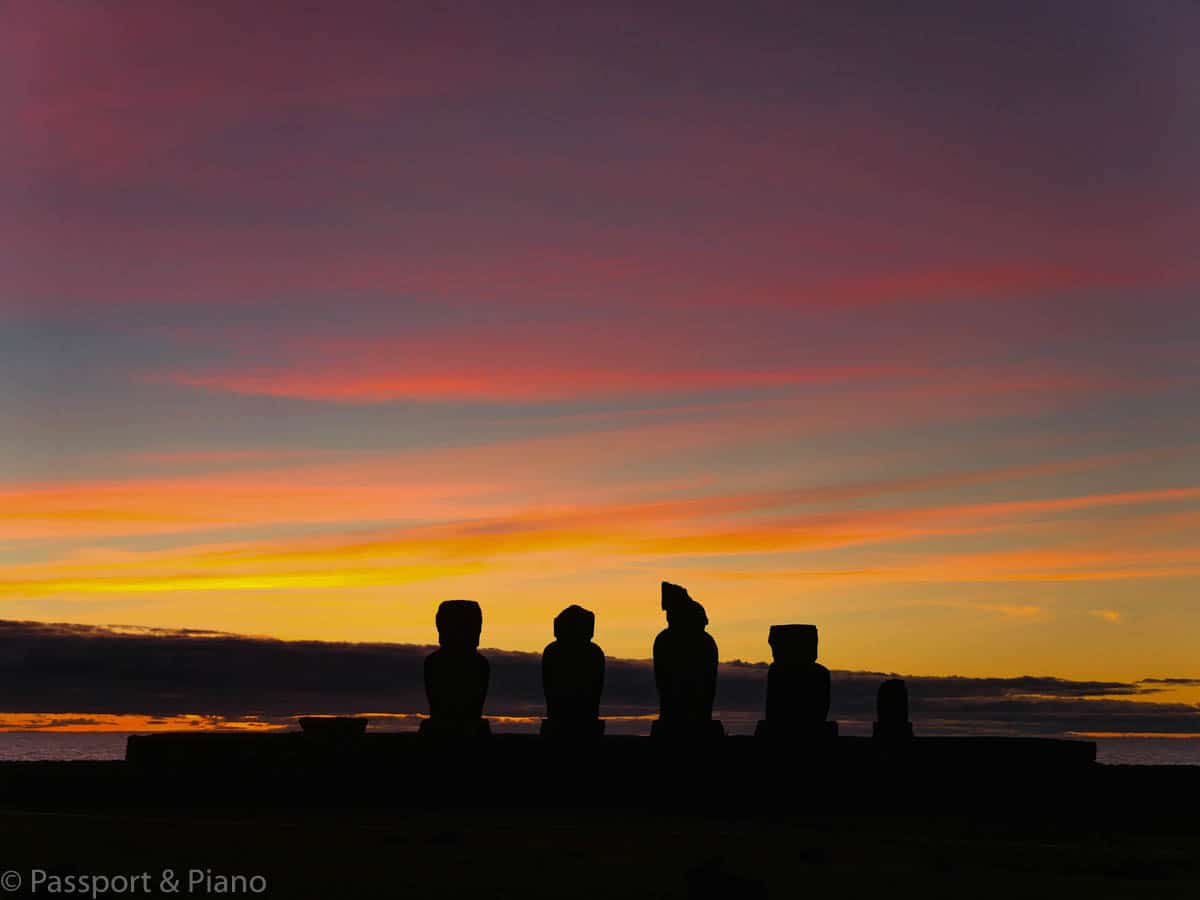
Like most restaurants on the island, the food isn’t cheap, but it’s delicious, and you’ll get a spectacular view of the sunset.
The food is Polynesian, but there are some international dishes on the menu, and they cater for vegetarians. The restaurant is close to the Easter Island moai Ahu Tahai.
Ahu Tahai
From the centre of town, it’s no more than a 15-minute walk to the ceremonial site of Ahu Tahai. It’s one of the most popular spots on the island to watch the sunset over the Easter Island figures.
The site is one of the oldest and dates back to 700 AD. It covers one of the largest areas with the ocean framing your view, making it an idyllic spot whether you visit during the day or night.
However, in the evening, the sunset turns the sky orange, and the Moai become stunning silhouettes.
You’ll often find people chilling out with a drink and playing soft music. The vibe is hypnotic.
I visited here most evenings and often found myself reflecting on my life and finding my inner peace.
The Moai are said to transmit ‘mana’ which is a mythical power, and I believe from experience there is some truth to this. You certainly feel full of emotion when you sit near one and ponder the world around you.
Ceremonial platforms at Tahai
There are three ceremonial platforms to admire at Ahu Tahai. On the far left is Ahu Vai Uri, an alter that has five statues. The carvings of each figure are different, and the weather has deteriorated some more than others.
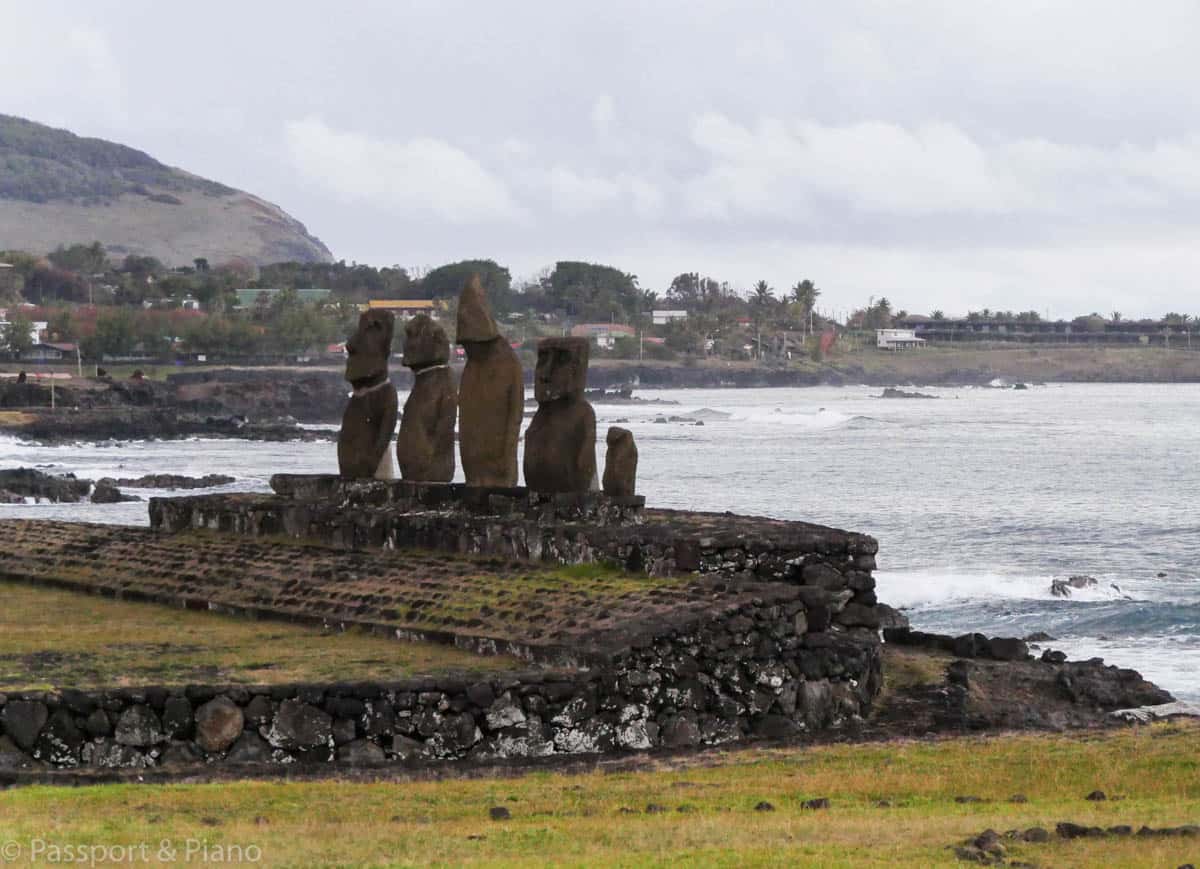
The next statue a little further over to the right is Ahu Tahai. It’s approximately four and a half metres tall and sits on the oldest platform.
On the far right is the giant statue Ahu Ko Te Riku. It is the best restored of all Easter Island moai statues. However, not all the features are original.
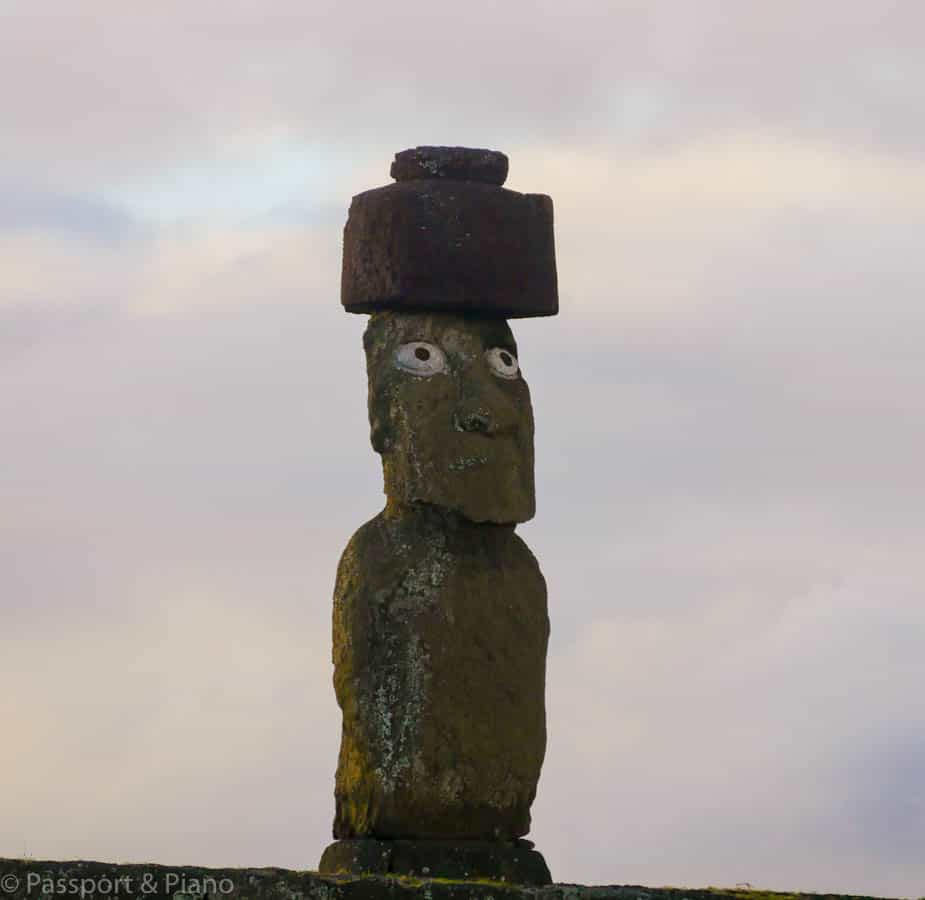
The red stone carving on his head is called a pukao and represents a hair bun. The white coral eyes were added in 1990 to give an idea of what they might have looked like originally.
Researchers believe that the eye sockets were carved out when the Moai was mounted on the ahu. The white coral eyes were then inserted during the ceremony so that the statue could come to life and protect its tribe through spiritual powers.
DAY 2
Following breakfast, make yourself a packed lunch or pick some snacks up in town as today I would suggest you take to the car and explore the island on the Southeastern circuit.
If you would prefer not to hire a car you can take a full-day tour of the south and east side of the island. If you want to take a tour that includes Anakena Beach, this one is highly recommended on TripAdvisor.
You’ll see signposts off the main road to all the sites and its easy to park when you arrive. Don’t forget to bring your National Park ticket that you purchased at the airport as you will need to present it at some of the sites.
From Hanga Roa follow Avenida Hotu Matu’a to the southern coast road. Look out for the big white oil containers and turn right to Vinapu just after them.
Vinapu
If you have visited the Inca sites in Peru, you will see the similarities at Vinapu. Tribal wars destroyed most of the Moai heads from their platforms during the 18th and 19th centuries.
However, you’ll instantly notice that the construction techniques of the ahu resemble those of the Inca’s. The methods are surprisingly similar if not linked to the those seen at Machu Picchu and other Peruvian Inca sites.
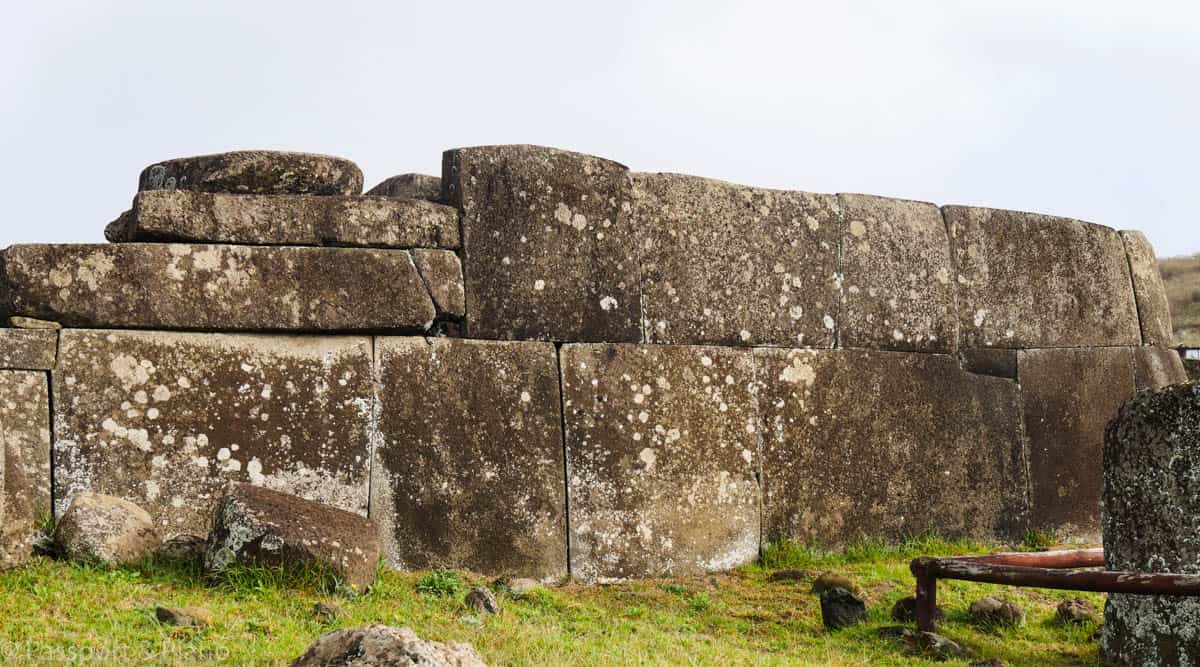
Large stones that weigh several tonnes are butted together with amazingly straight joins and no mortar. Incredible considering it was all done by hand.
You’ll also see several of the heads and pukao’s scattered around. Sadly many of the features have deteriorated and its thought that some may never have reached the original platform.
There is an interesting red column that’s worth seeing as it’s thought to be the remnants of one of the few feminine moai statues. Its made from red scoria which is the same stone used to make the pukao’s.
Paina
You can also see a circle of stones called Paina in front of the ahu. These are significant as the area inside the sphere had special ceremonial significance in times past when tribal leaders performed rituals here.
Continuing along the coastal road in the direction on Anakena you’ll pass a couple of smaller sites over the next 3 kilometres before arriving at Ahu Akahanga.
Ahu Akahanga
At the entrance to this site, you will see one of the best-preserved ancient villages which gives an insight into Easter Island civilization in times past.
If you walk from the remnants of the old boathouses to the cave, you’ll pass through what was the cooking area.
You can see several Umu or ovens as we now call them on the ground. The cave is tiny, but you can go inside and get a feel for the shelter that they provide.
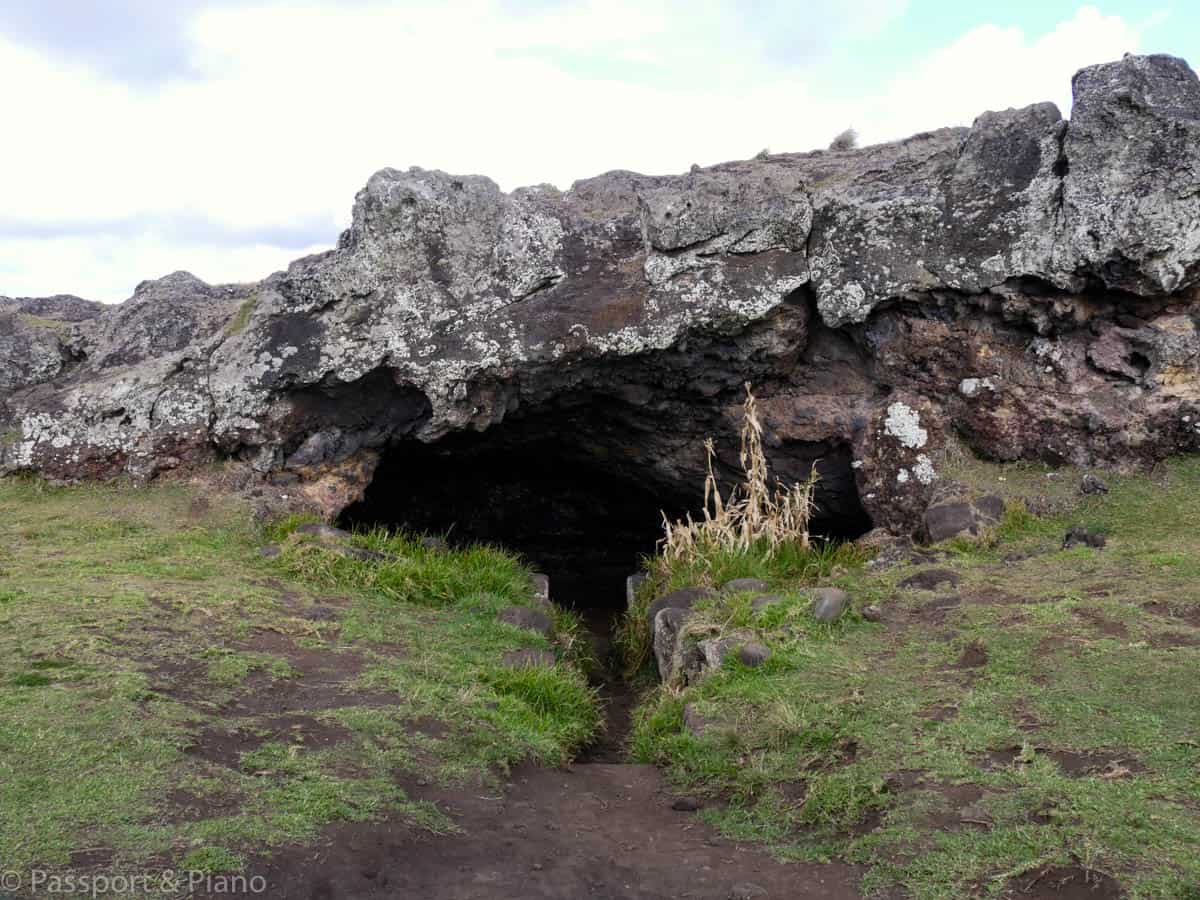
People who were not considered important enough to sleep in the boathouse would have spent their nights sleeping in the cave.
The ceremonial site of Ahu Akahanga looks the same as when explorers such as James Cook arrived.
Once restorationists move the stone, much of the archaeological data is lost. Hence sites like Ahu Akahanga are essential for today’s archaeologists who continue to study the remains.
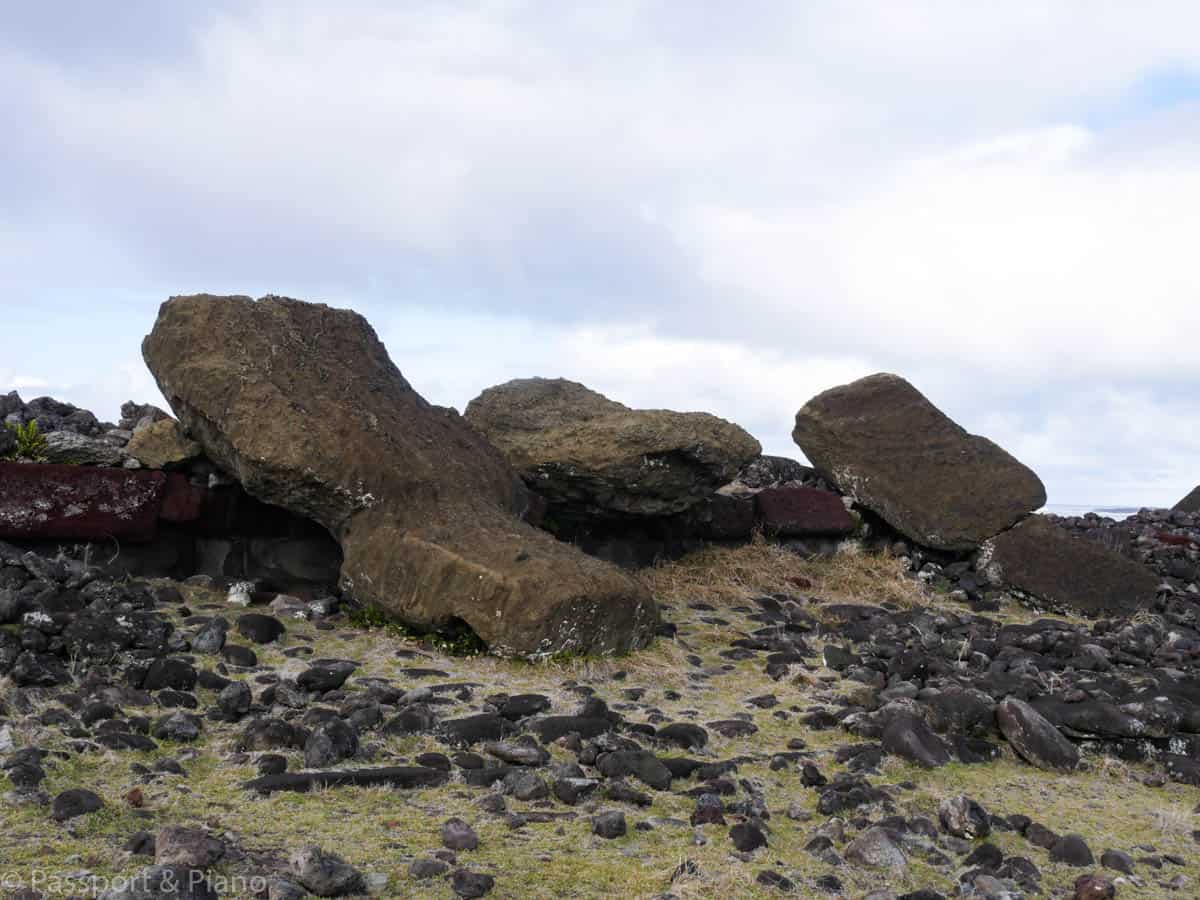
There are 13 statues here, and unusually they were knocked down with their faces facing upwards. Hence you can observe the detail in the carving work more closely.
Easter Island Mystery?
According to oral tradition the first king, Hotu Matu’a of Easter Island is buried at this site. Excavations previously carried out have never discovered the remains of the king.
However, research has shown that there is a geological and astrological relationship between this site and the burial site of his sister Ahu Te Peu on the other side of the island.
Further along the coast road is Ahu Hanga Tetenga which is worth a quick stop.
Ahu Hanga Tetenga
Tetenga is the largest Moai ever transported to an easter island ahu (platform). It’s just under 10 metres long, and it does make you think about how inhabitants moved these easter island giants without machinery.
Upon leaving Hanga Tetenga, the road splits. Take the left-hand fork Camino de Los Moai and follow the signs to Ranu Raraku.
Rano Raraku
Rano Raraku is one of easter island attractions that you must visit.
Aim to get here early before the crowds arrive to ensure you can experience the beauty of the place in peace. You can easily spend several hours here, and I guarantee you’ll be mesmerized by some of the Moai statues.
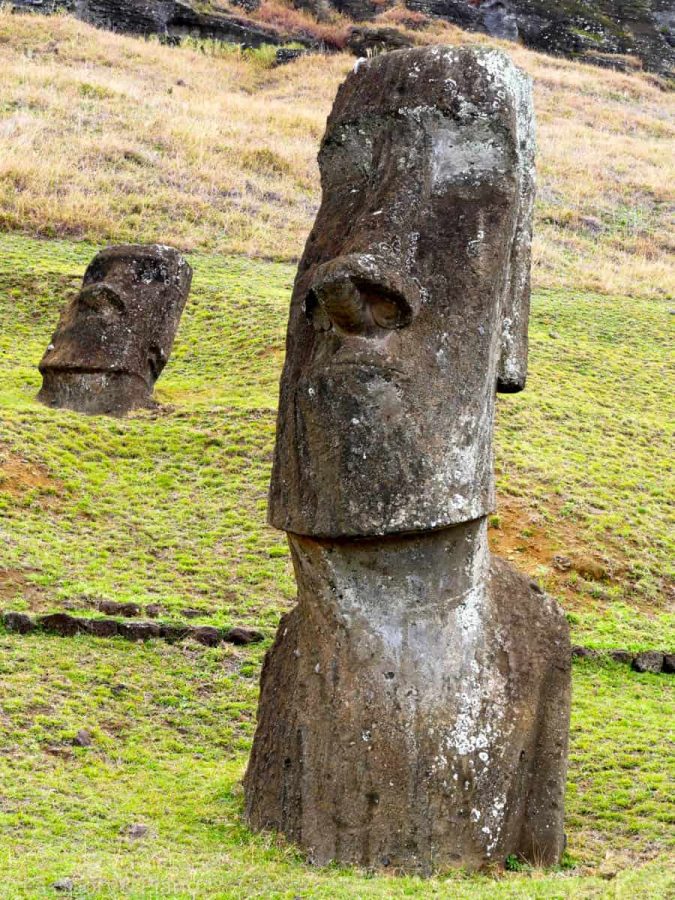
At the entrance, there is a hut where the gatekeeper will stamp your national park ticket. You are only permitted to visit Ranu Raraku once so make the most of your time here.
Rano Raraku volcano is one of the most revered archaeological sites in the world. It’s a place full of mystery and magic, but primarily its where the easter island moai heads originate.
The volcano is now extinct, but it left behind a unique type of rock called Lapilli tuff. Hardened volcanic ash is the primary substance of the stone.
It’s much softer and more accessible to carve than the usual basalt rock found elsewhere on the island. The Rapa Nui people would sculpt the Moai in the quarry before transporting them to their aha’s around Easter island.
There are 397 statues to see at the quarry, in all stages of production. Some are complete, others are still being carved from the rock face and some have fallen. The Rapa Nui would not complete any Moai that fell as they believed that their Mana had disappeared.
On entering Rano Raraku, there are two paths to follow. The right trail leads to the quarry and the other to the left takes you to the crater. You should explore both, take your time and enjoy the experience.
The Quarry
The path to the right takes you through the quarry and begins at the carving section where you see row after row of unfinished Moai. The Rapa Nui completed all the statues in situ and carved them facing upwards.
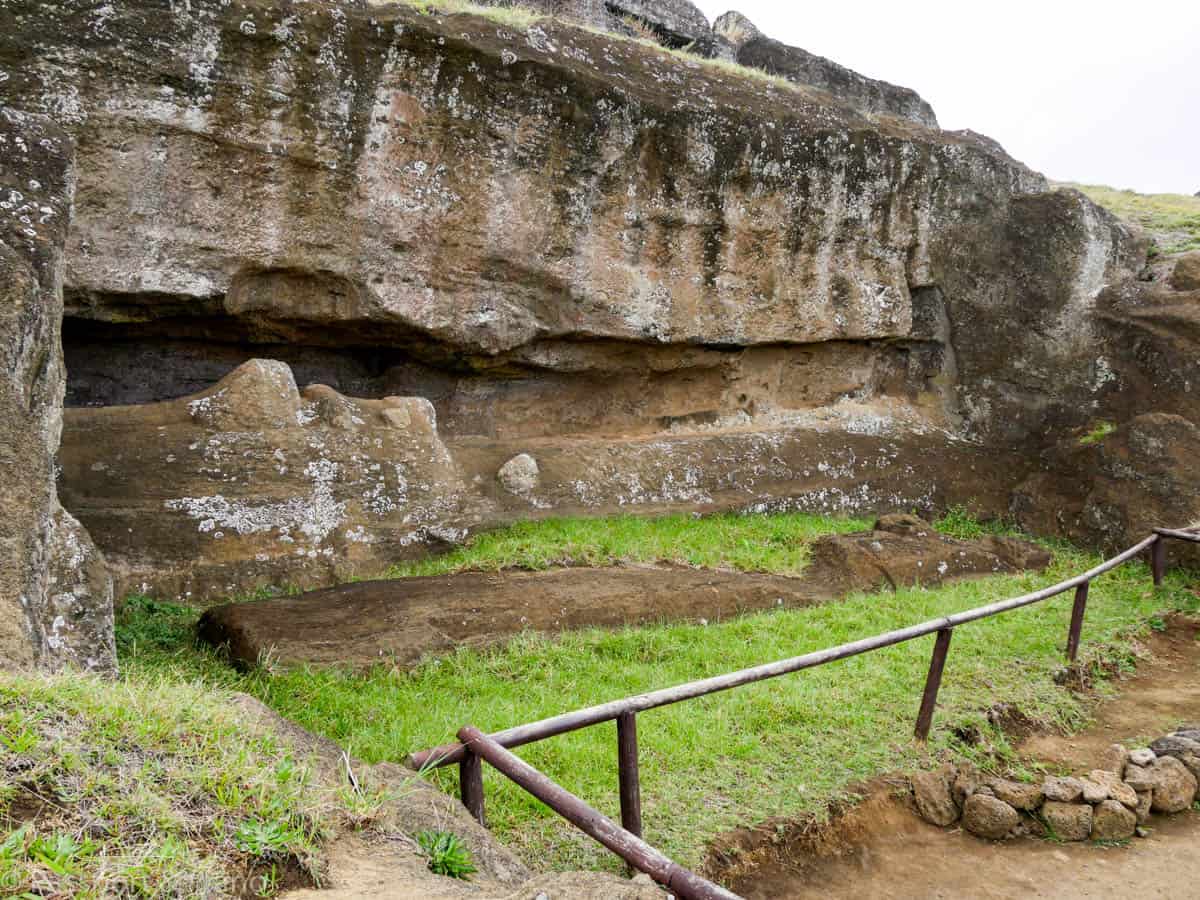
Once the front was complete, the men would chip away the Moai from the bedrock to give the carvers access to their backs. All the statues in this part of the quarry are in the original place that the Rapa Nui left them.
You’ll notice that some Moai are standing, some are horizontal, and others are still to be set free from the bedrock.
Further along the path, you can see only the heads of statues. Why? Over the years the soil has buried the bodies leaving just the upper sections on the surface.
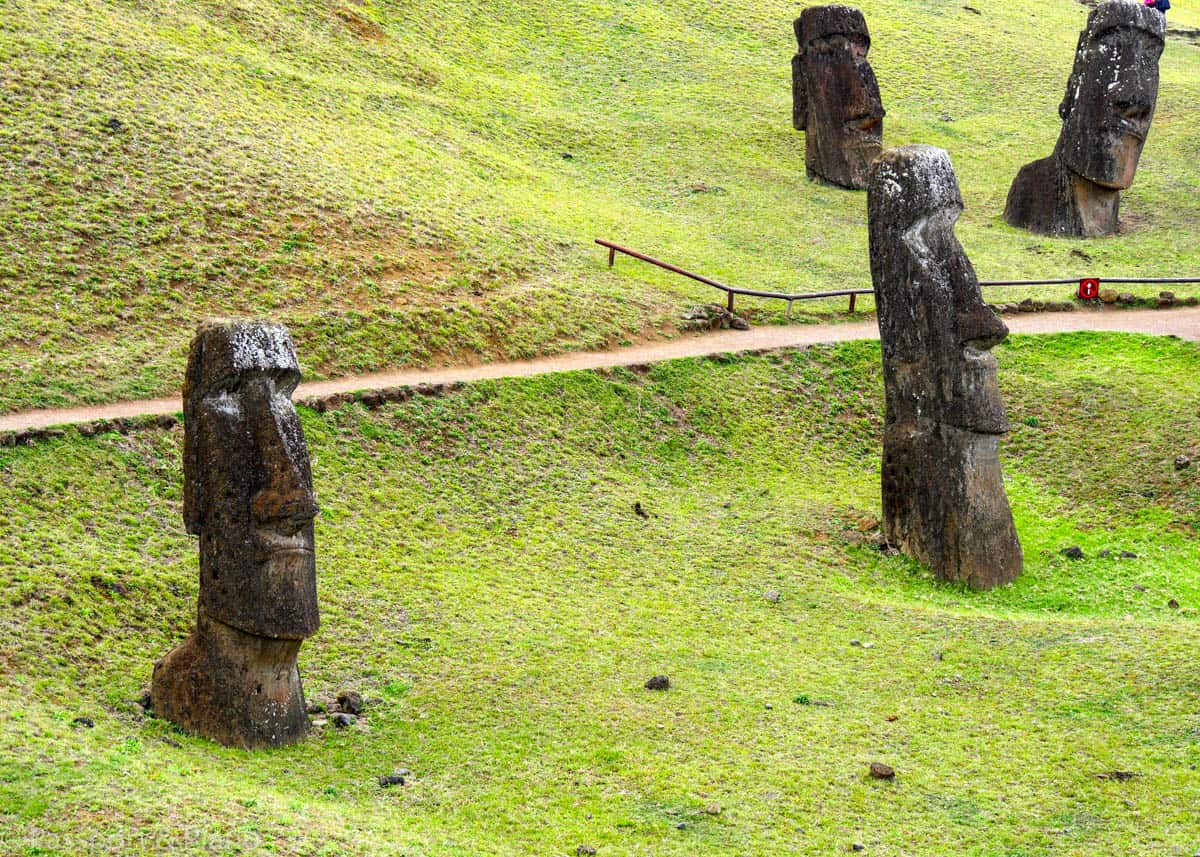
The earth is the best way of preserving the rock, so archaeologists have left them this way. The head is said to be at least 1/4 of the size of the body so you can estimate the size of the full statue.
The path around the quarry takes you in a loop and allows you to see everything.
The Path to the Crater
It will take you around 10 minutes to reach the crater, but the path is a little precarious and steep in places. Hence, it’s essential to wear appropriate footwear.
The cavity used to be one of the only sources of freshwater on the island, and you can often see some of the wild horses coming to take a drink here.
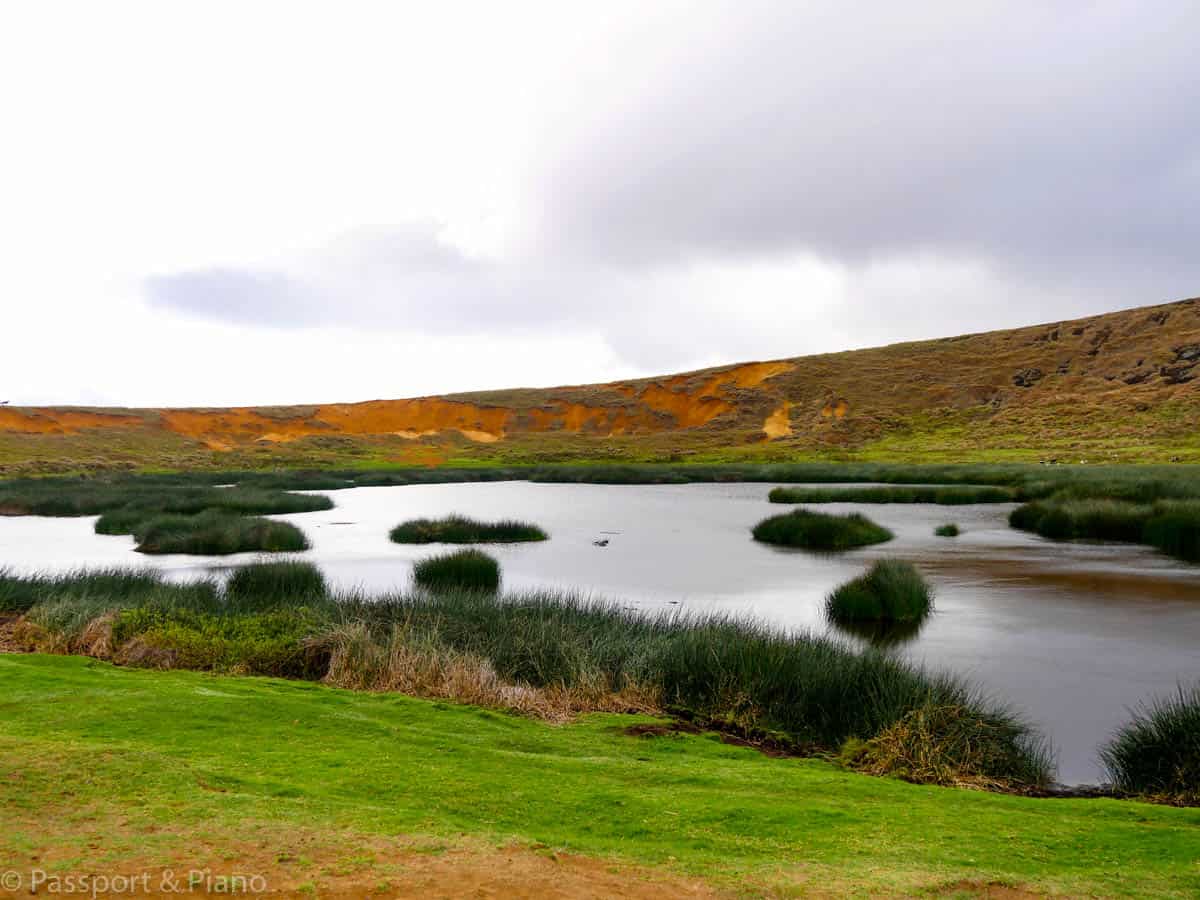
Unfortunately, you can no longer walk around the crater. Still, there are several benches to sit and enjoy the splendid vistas. The coral trees provide shade, and as far fewer visitors make it up to the crater, it’s a perfect place to indulge in the beauty of the island.
Tapati Festival
During the easter island festival of Tapati, the crater is the venue you for the triathlon which resembles the Birdman race.
The competitors have to paddle across in canoes made from reeds, before picking up two bunches of bananas and running one and a half circuits of the lake. They then swim across on top of a Pora.
Facilities at Rano Raraku
There is a gift shop at Rano Raraku, and toilet facilities so do take advantage of these before continuing.
There are also several benches that you can sit on and eat your packed lunch. There is also a cafeteria if you want to purchase something to eat.
Ahu Tongariki
After enjoying a couple of hours at the quarry continue the short distance along the coast road to Ahu Tongariki.
The 15 heads here make Ahu Tongariki another of Easter Island must-see sites.
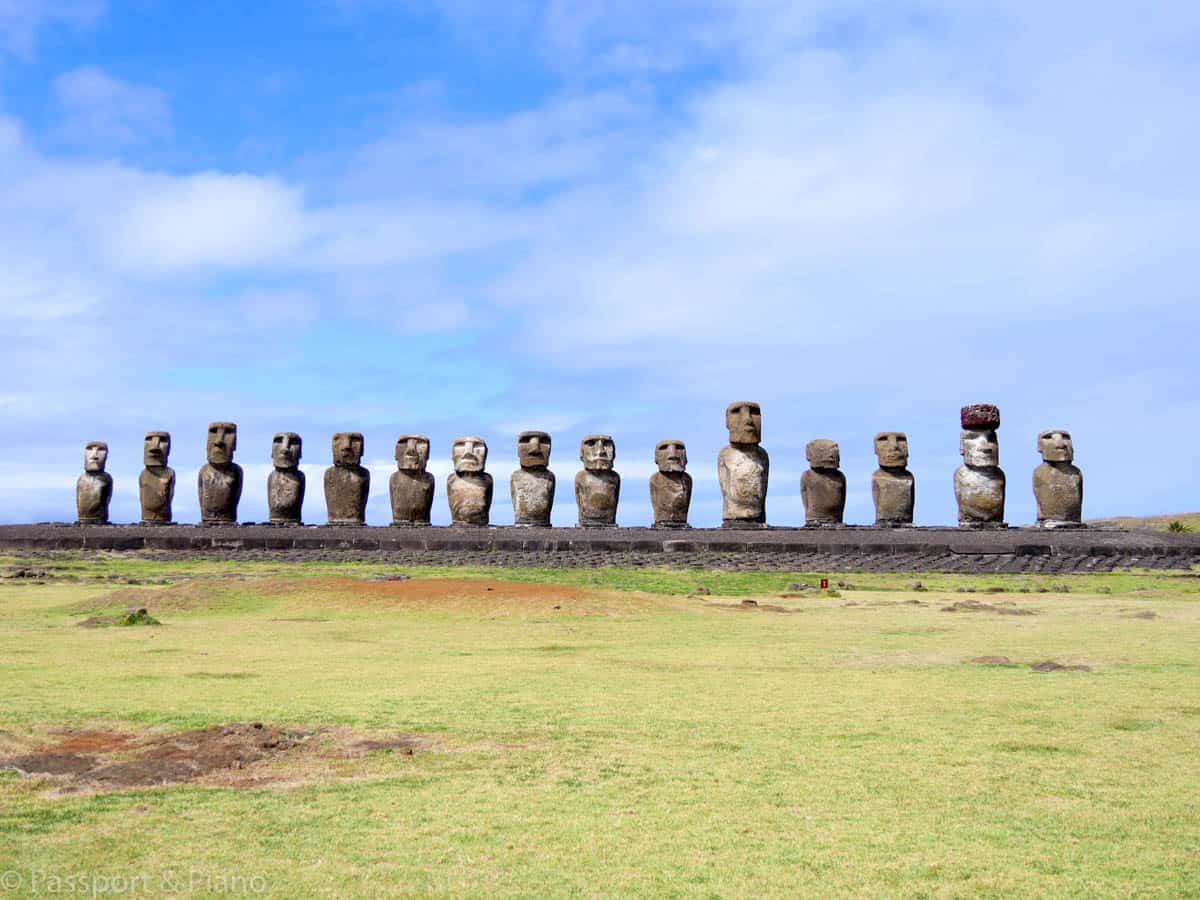
The Moai look their best at sunrise, which I’ve included on tomorrows schedule.
The sun rises behind the statues turning them into black silhouettes which are a photographers dream photo. The less cloud, the more orange the sky becomes so you may have to get up early on a few occasions to get the perfect snapshot.
During the day though it’s worth stopping to fully explore the site as not only are the statues worth seeing there are also some interesting rock paintings to view.
Ahu Tongariki has the most statues on anyone platform throughout the island. Sadly though a tsunami in 1960 destroyed the Moais.
Still, in 1988 a former governor of the island mentioned on a Japanese tv show that they needed a crane to save the Moai. Tadano, a private construction company from Japan, came to the rescue and with the help of funding from the Japanese government, Ahu Tongariki was fully restored in the 1990s.
You’ll notice on your left-hand side as you approach the platform seven giant topknots. Unfortunately, they could not move these due to their fragile state.
You can walk around the whole platform, which is 220 metres long. From the back, you get a much better perspective of the actual size of the giant easter island monoliths and the statues.
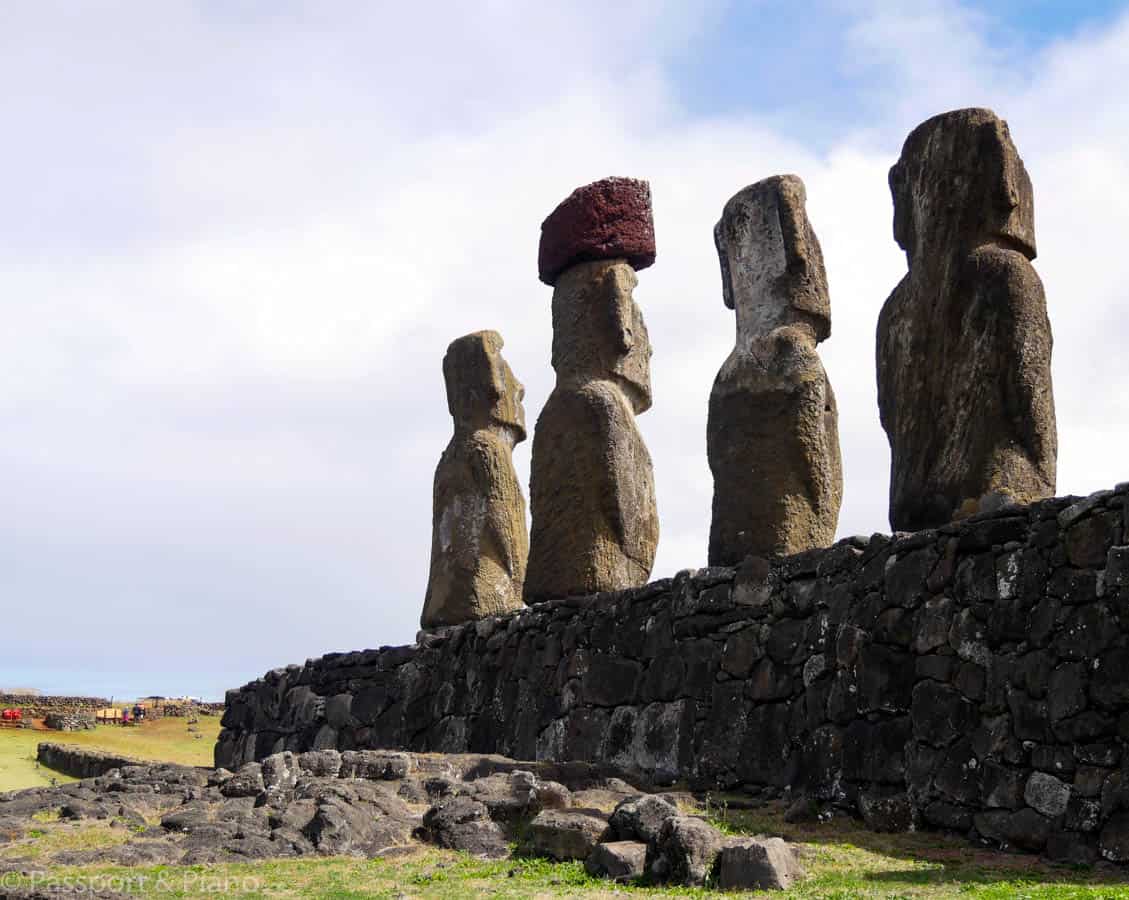
There is also a rectangular chamber where the remains of a significant amount of human ash were excavated. The Rapa Nui people used Tongariki over several centuries as a ceremonial burial site.
Petroglyphs
After admiring the magnificent Ahu Tongariki take time to seek out the rock carvings further back towards the perimeter stone wall where the road bends to the right.
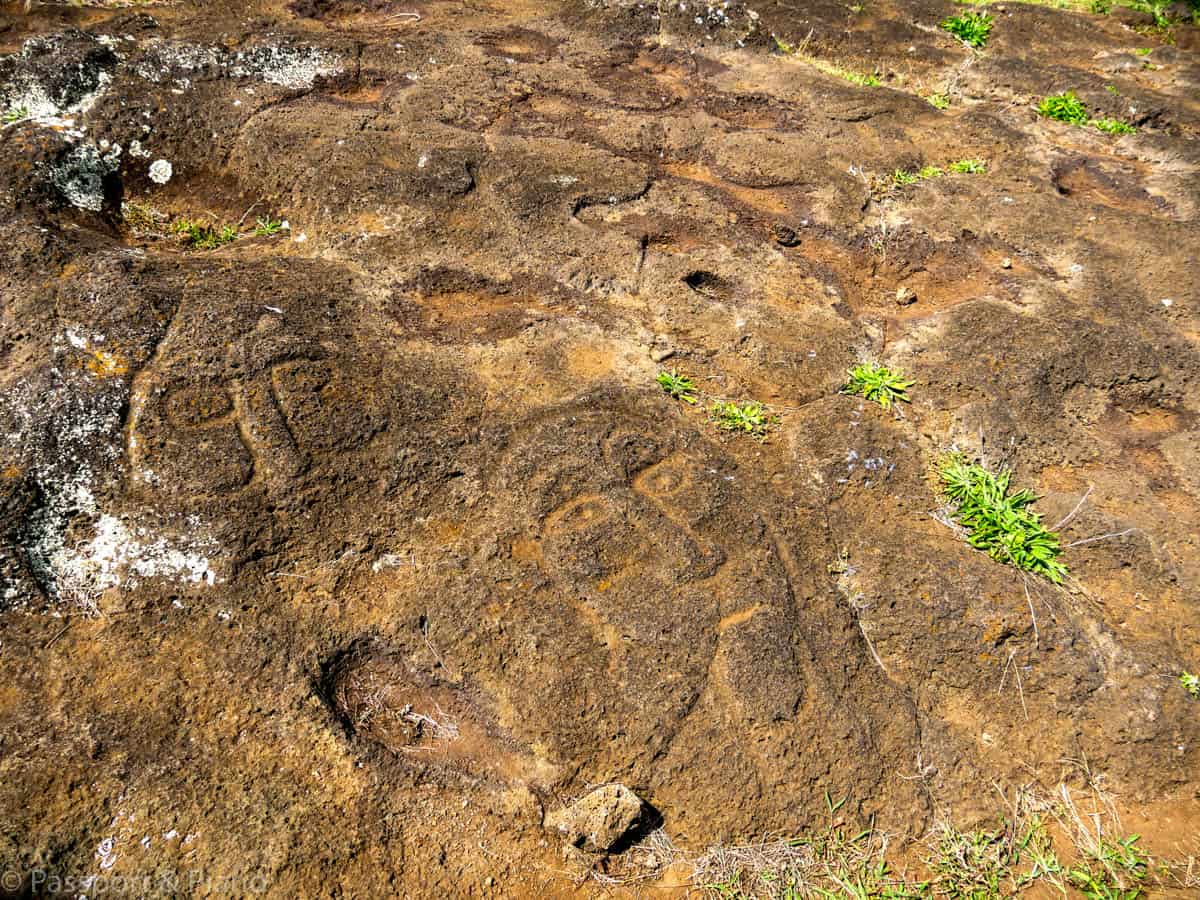
The petroglyphs have wooden platforms to view them from, and the images of tuna and turtles are quite clear.
Papa Vaka
There are some more exciting petroglyphs worth stopping at as you continue along the coastal road towards Anakena beach.
It’s best to visit the site of Papa Vaka in the late afternoon, as its easier to see the rock carvings but you can make them out at any time of day.
The viewing platforms are excellent, and the information boards mark out and describe the pictures. Hence, you should be able to work out what’s in the image.
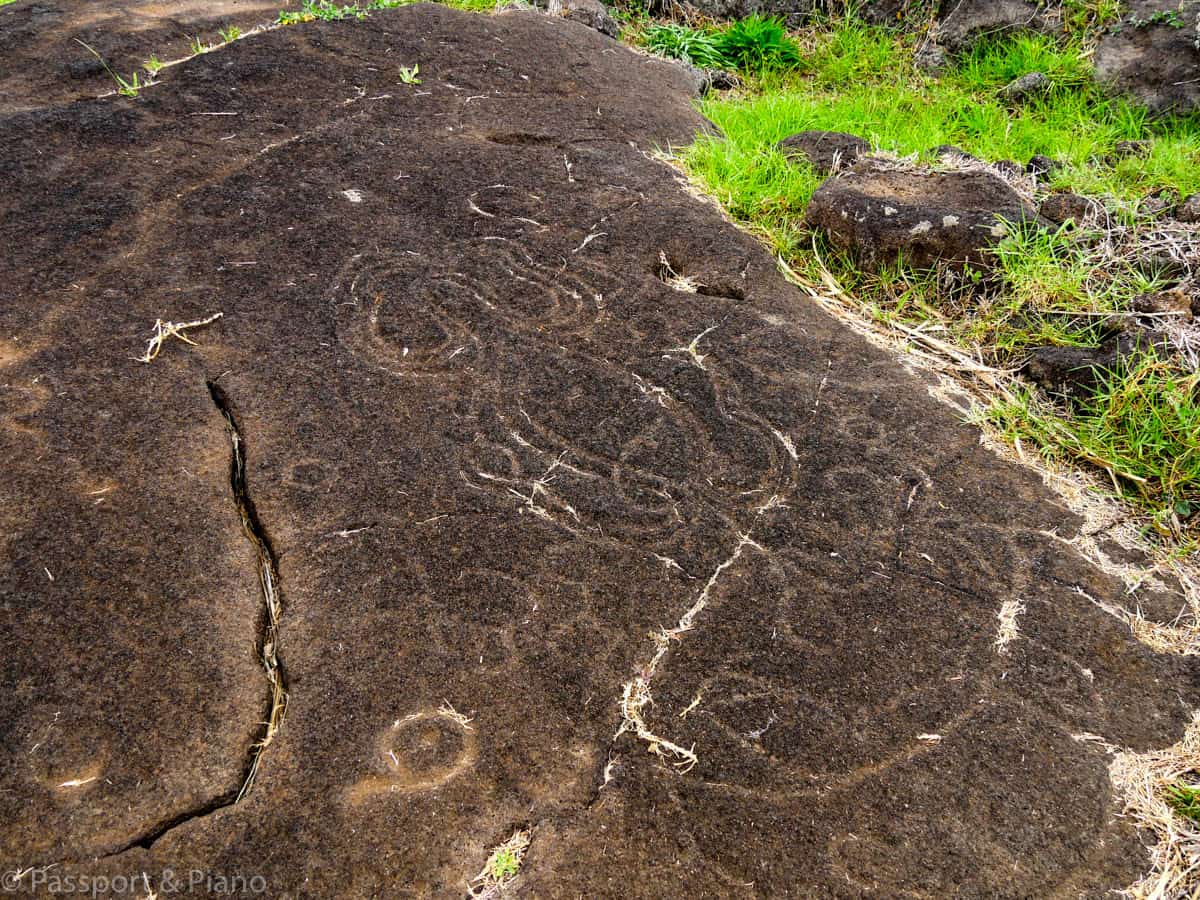
There are a couple more Easter Island heads to see in route to Anakena but you may have seen enough for one day.
Anakena Beach
Anakena is the main beach on Easter Island and its idyllic.
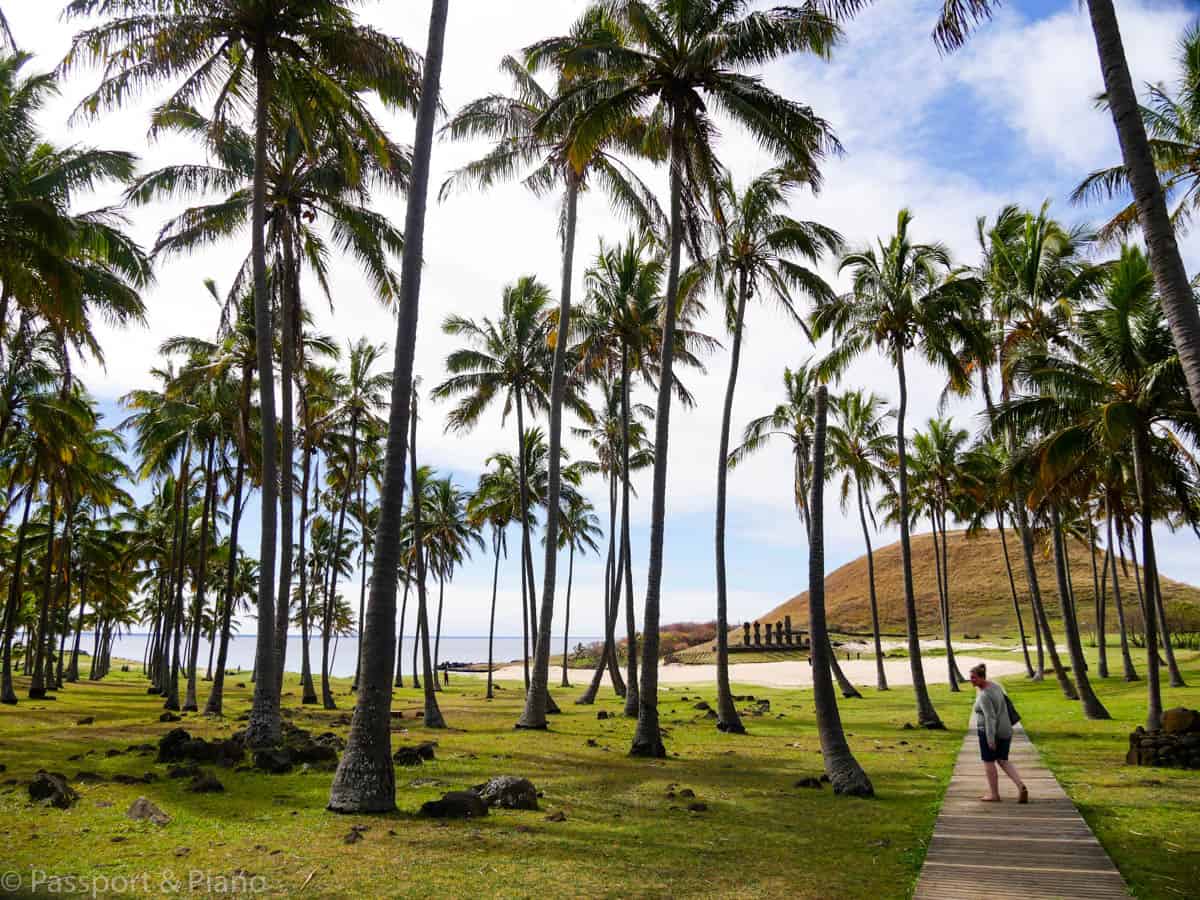
You can swim in the water here at any time of the year as the temperature varies very little between summer and winter.
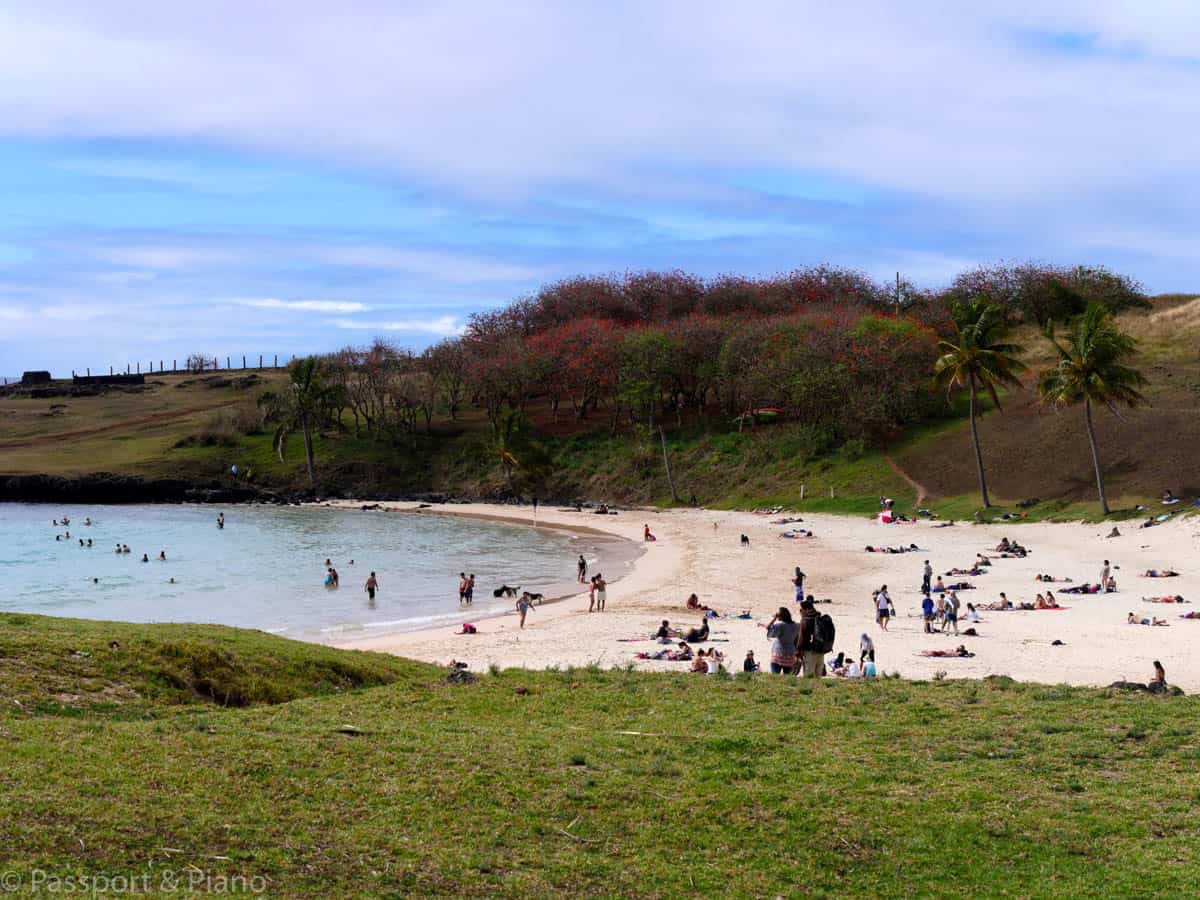
It’s also an important place historically as it’s where Ariki Hotu Matu’a and his men first arrived on the island, and the origins of the Rapa Nui culture began.
The best-preserved ceremonial site Ahu Nau Nau is here. When the seven statues fell, they were hidden under sand which stopped them from eroding.
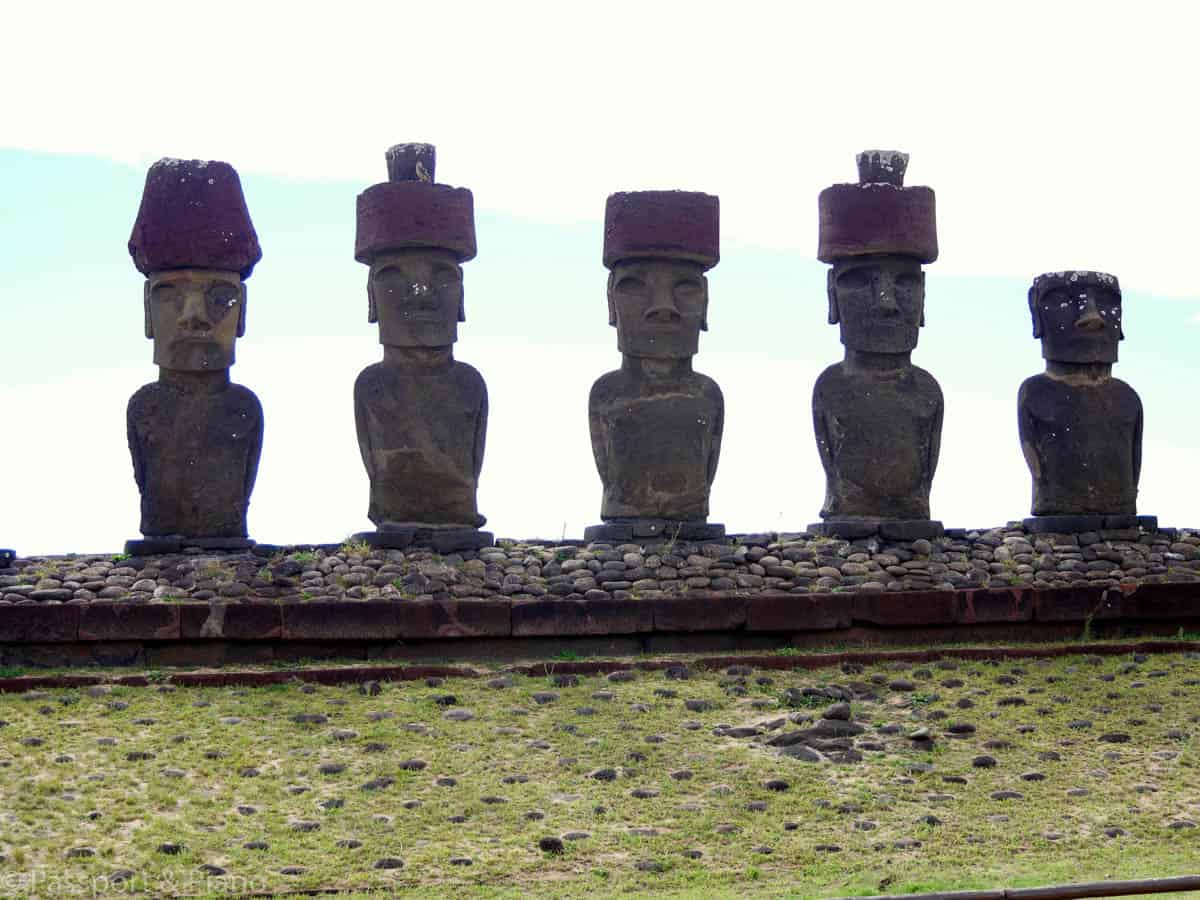
Sergio Rapu and his team restored the site and its now the dominant feature of the area. Archaeologists have discovered that there were three stages of construction here, the oldest Nau Nau dates back to 1100 AD.
The carvings on the back of the Moai are also worth observing. These are the only statues outside of Ranu Raraku that have engravings on their backs.
Facilities at Anakena
There are public toilets here, and the beach has lifeguards in summer. There are a couple of snack bars nearby and a restaurant which serves food.
Having spent some time relaxing on the beach and enjoying a cocktail, head back to Hanga Roa on the inland road.
Evening visit to a Cultural Show
In the evening you could head back to Tahai to watch the sunset or book tickets to see an Easter Island dance show.
There are a couple of venues around town that hold traditional dance spectaculars, and it’s worth seeing one while you’re on the island.
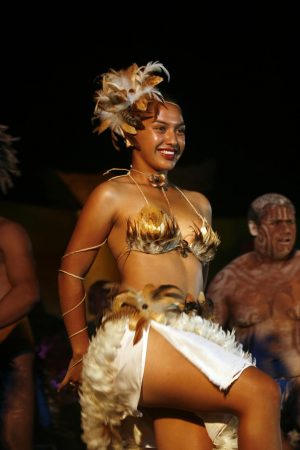
On Tuesdays, Thursdays and Saturdays Ballet Kari Kari is famous, and on Mondays, Wednesdays and Sundays you can head to Yai Te Mihi.
You will need to book tickets in advance, and prices can include dinner if you prefer.
DAY 3
An early start today if you want to catch the sunrise at Tongariki. Depending on the time of year that you visit sunrise varies between 7.15 am in December to as late as 8.25 am in September.
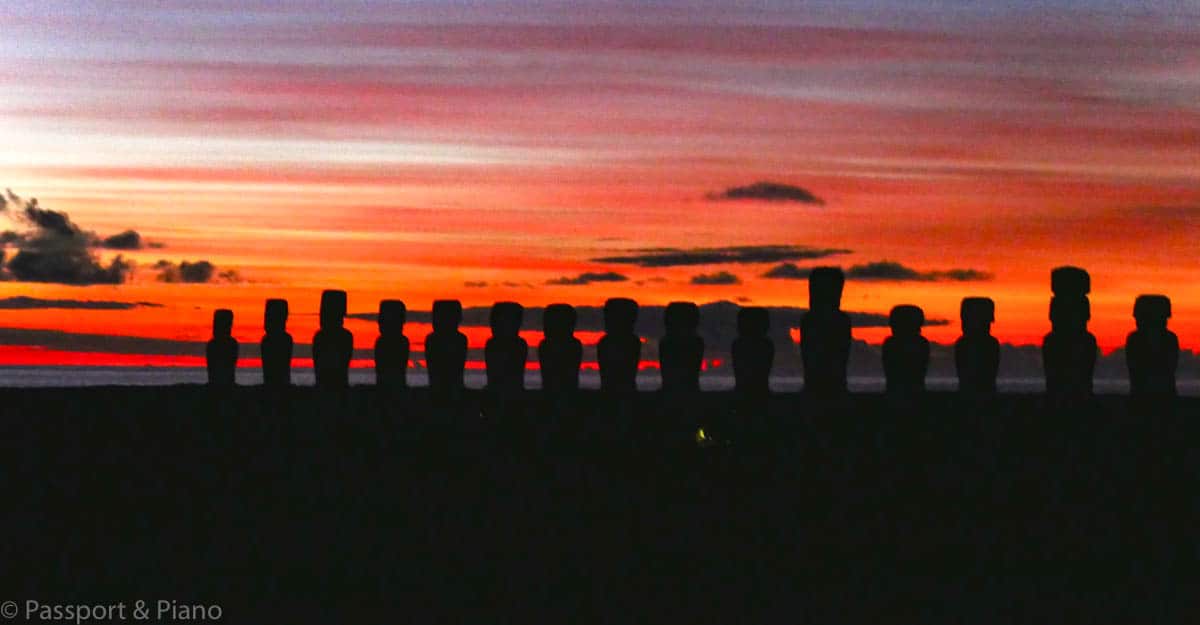
From Hanga Roa, it takes approximately 30 minutes to drive there so leave in ample time as you want to get the right spot and of course you want to arrive before the sun starts to rise.
You can also book a trip to see the sunrise at Tongariki if you do not have your own transport.
It is a magical experience, especially when the sky is free from clouds. The bright reds and yellows make for a spectacular display.
If the sun is bright enough (i.e. no clouds) the Moai statues look like black silhouettes. We made the journey a couple of times during our stay as on the first two occasions; there was too much cloud to get the picture-postcard image that I was hoping to capture.
Thankfully on our third attempt, the sky was clear, and the magnificent skyline was worth the wait.
After watching the spectacular sunrise, return to your hotel to enjoy breakfast.
Orongo Village
Today I suggest you visit Orongo which is to the south of Hanga Roa. You can either walk there by following the Te Ao Path from the gardens of the CONAF. Or you can take the car.
Guided tours of Orongo village are also a popular choice.
From town take the main road and turn right at the T junction with the airport road. You will pass the petrol station and keep going until you reach the car park for Orongo.
On the way, it’s worth stopping at the Island Lookout as the views are incredible.
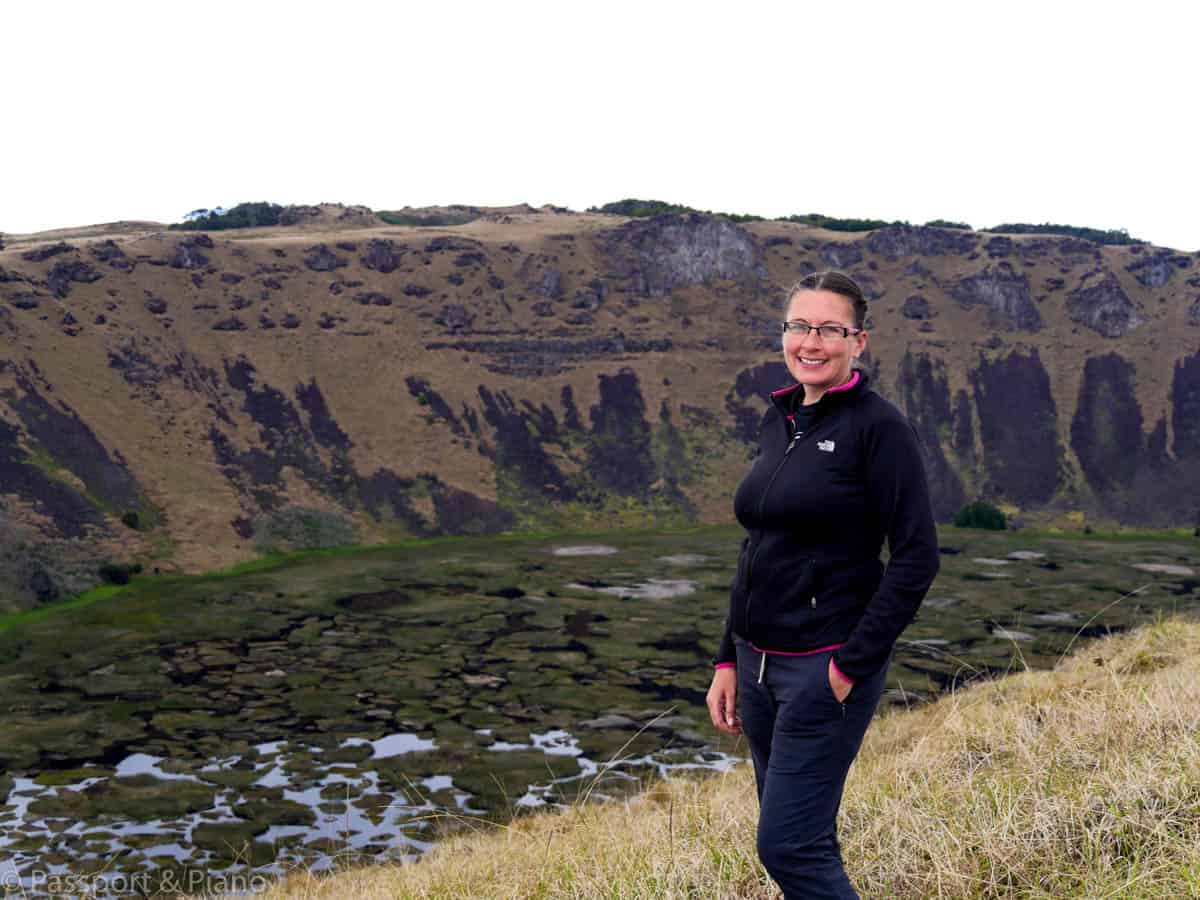
Orongo was a ceremonial village where the Easter Island inhabitants once frequented. It’s also where the easter island birdman competition took place.
As one of the highest points on the island, the views are magnificent both across the pacific ocean and the crater of Rano Kau’s volcano.
On arrival, you have to sign in at the visitors centre and show your National Park entrance ticket. There is a small visitors centre with some informative display boards which are worth a peruse before taking the path down to the village.
Motus – small islets
The route begins to the right, and you can see the three offshore islets, which are called Motus. The largest one is called Motu Nui.
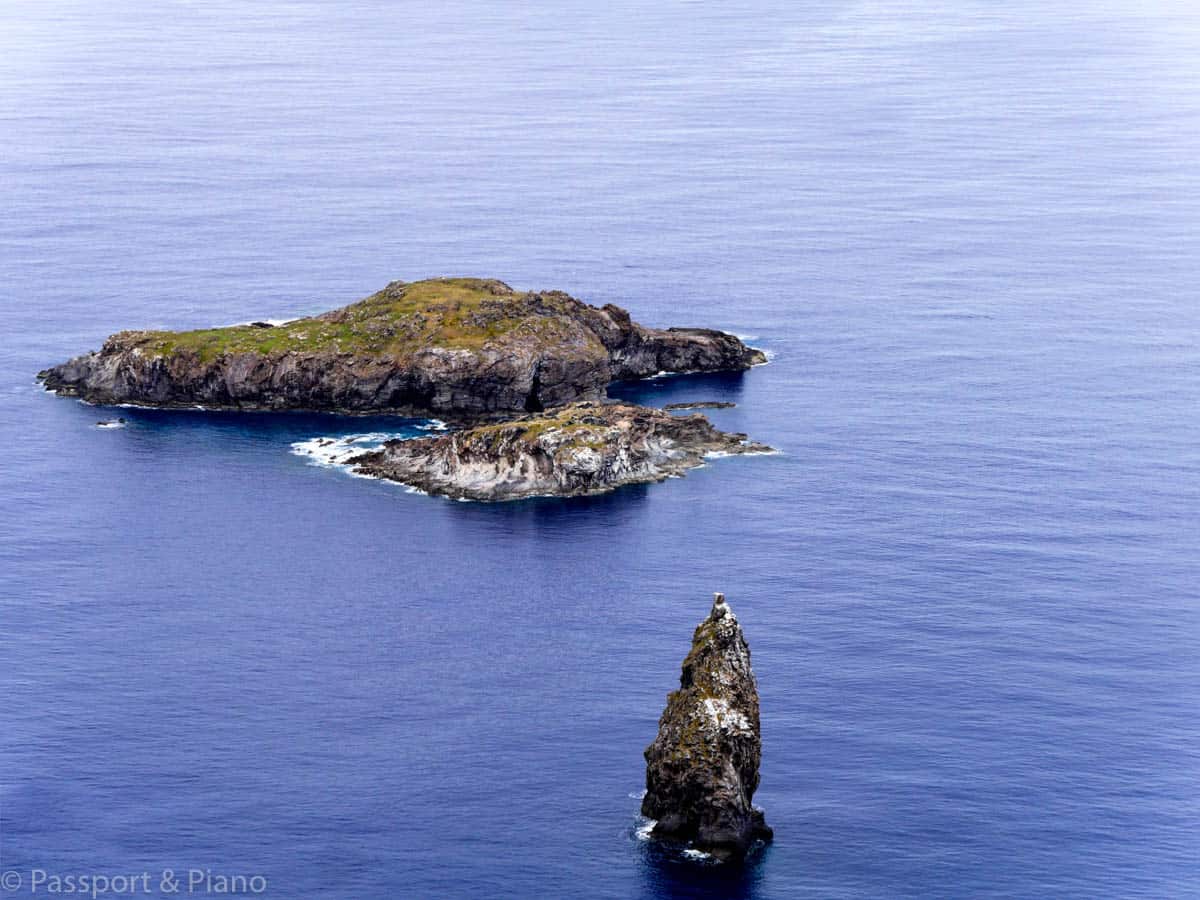
Due to the location, Rapa Nui people did not live permanently in the village.
However, locals would use it for ceremonies, including the coming of age rituals of young children. In the late 17th Century, the importance of Orongo grew. Acts of vandalism from the numerous tribes had destroyed the island, and order was in need.
Previously each tribe was led by a chief, but now the annual Birdman competition was to determine who took leadership.
Birdman Competition
Every year Sooty Terns came to lay their eggs on the island and upon their arrival tribes would send their participants to Orongo. Once the race was declared open, these men would descend the formidable cliff face towards the ocean where they would swim the 2km to reach Motu Nui.
They camped in caves on the islet while they waited for the first Sooty Terns to lay their eggs. The first man to get their hands on one was the winner.
The winning tribe gained a lot from holding the prestigious position as they had early access to the island’s supplies.
The competition continued until 1867, and the interviews led by Katherine Routledge document the latter years of the game.
The houses of Orongo Village
In 1974 a group of islanders and William Mullow restored the village at Orongo. The Rapa Nui constructed the houses from basalt slabs.
They have thick walls to stop the wind and tiny openings that you can only get through by crawling.
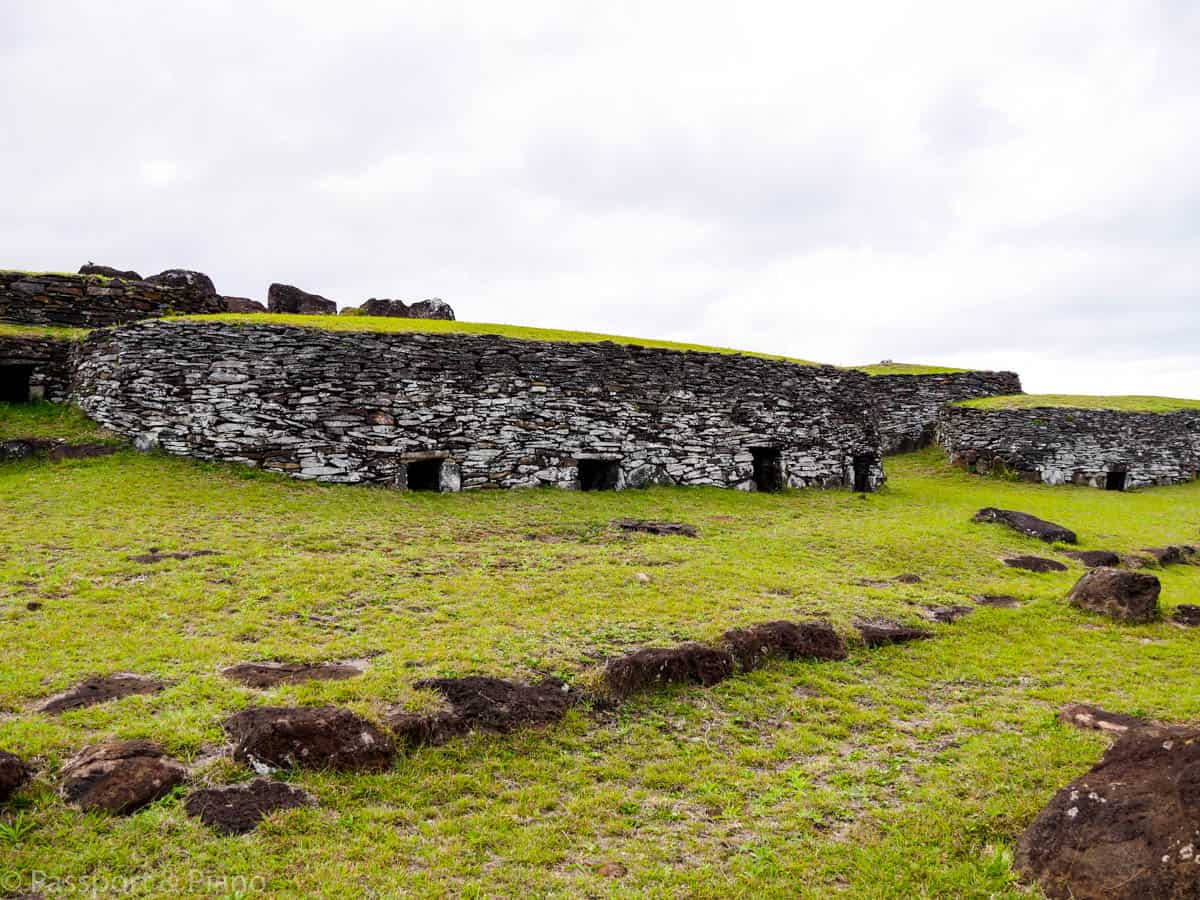
You can see inside some of them as the restoration team left them partly uncovered.
Nearly all of the entrances face outwards towards Motu Nui so that the residents could watch the Birdman competition.
You’ll notice that one of the larger houses has four openings. The Moai statue that now resides in the British Museum was taken from here as a present for Queen Victoria by the crew of HMS Topaze in 1868.
The most spectacular view is from the end house, which is where the priests stayed during the competition. There are a couple of magnificent Easter Island carvings (petroglyph’s) here depicting the birdmen.
From the last house Mata Ngara’u you can follow the edge of the crater and enjoy some more breathtaking vistas.
It’s worth enjoying your time here as you can only visit once in the hope of keeping visitor numbers to a minimum.
Return to Hanga Roa for Lunch
On your way back to Hanga Roa make a stop at Ana Kai Tangata near the Hotel Iorana.
Ana Kai Tangata
Ana Kai Tangata is a cave which has a large opening near the sea making it easily accessible.
The rock art inside the cave is arguably the best on the island. The paintings in red, black and white mostly depict one of the Easter Island birds, Manutara.
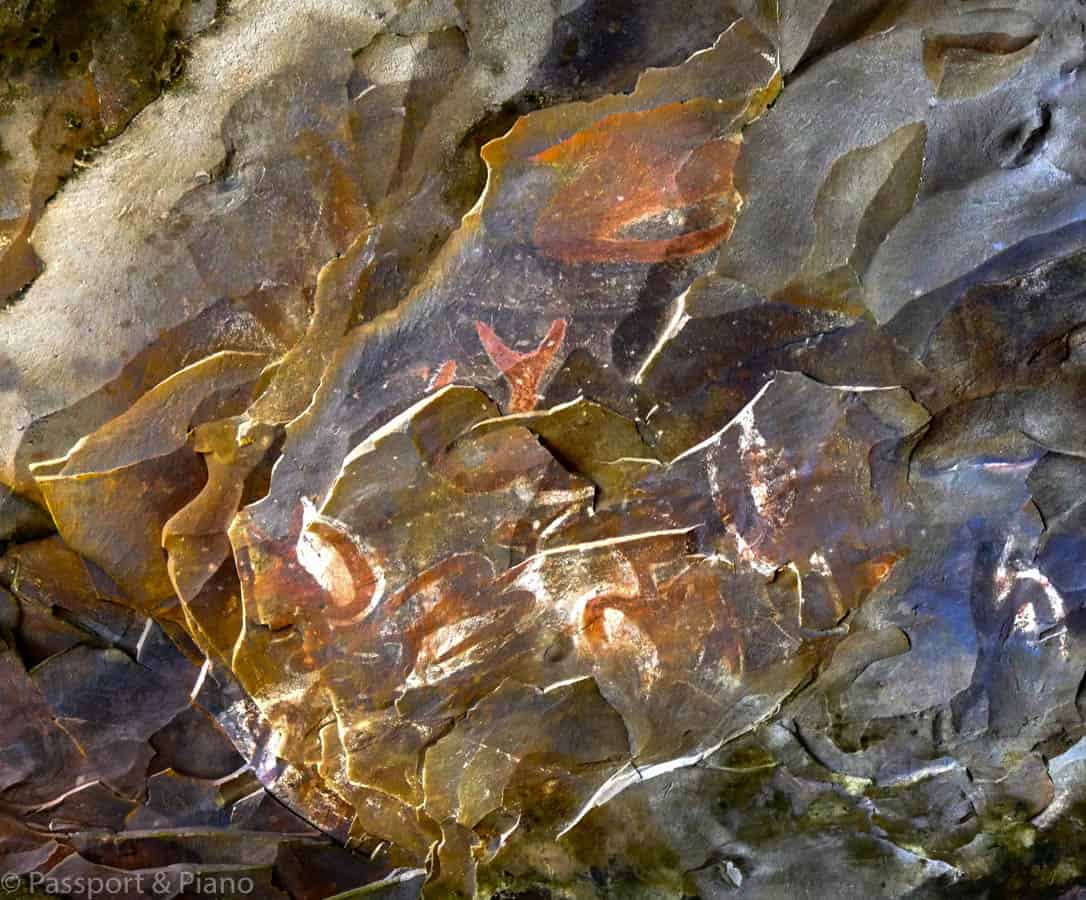
The bird is similar to a seagull and was considered sacred. It was the main icon of the Birdman.
To get to the cave there, it is quite a descent down steps carved out of the rock.
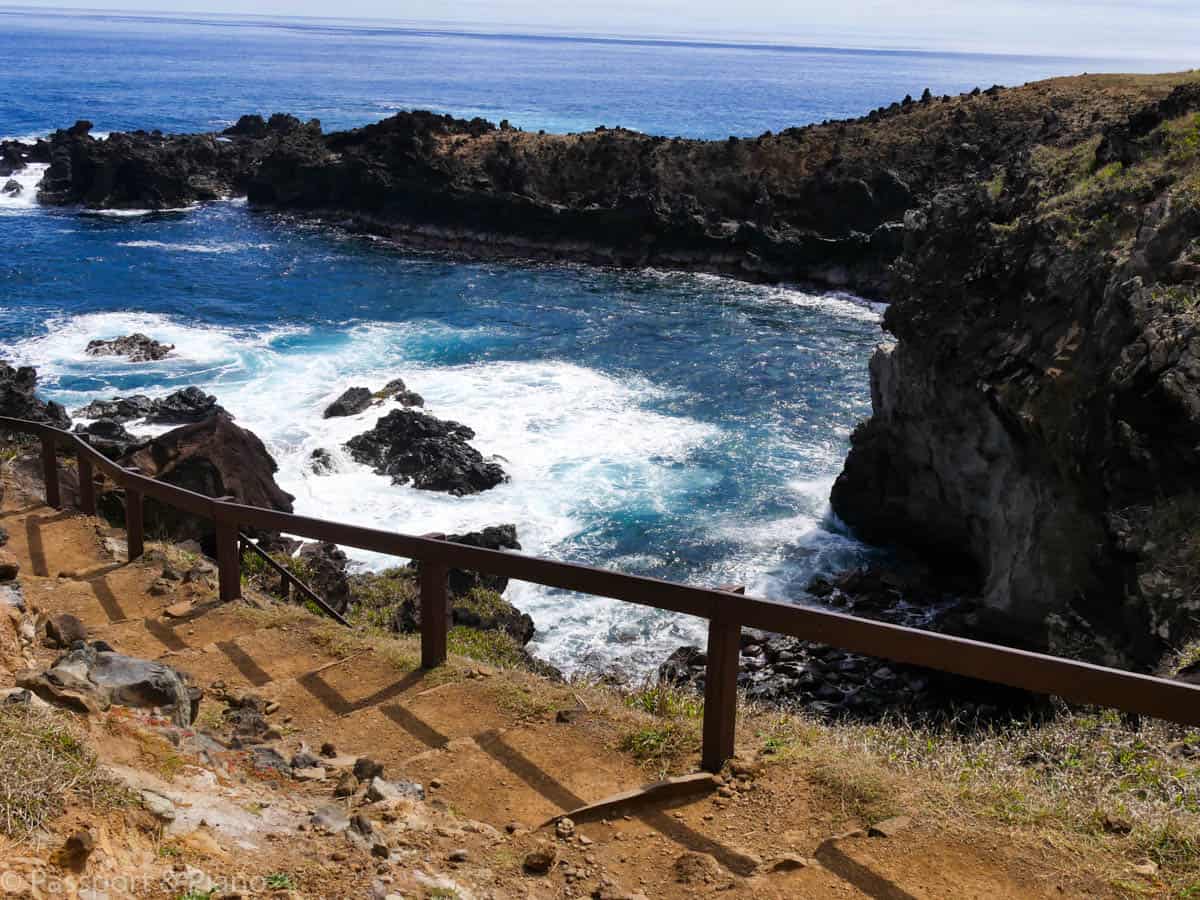
Of course, that means there’s quite a climb after your visit. The footing around the cave is rather precarious so ensure you are wearing sensible footwear and take your time.
Lunch at La Kaleta
For spectacular ocean views stop at La Kaleta restaurant before continuing up the eastern side of the island.
The restaurant serves delicious seafood as well as Polynesian food. Vegetarian food is available, and I can personally recommend a Pisco sour if you’re not the one driving.
It’s in a beautiful spot, and the food is reasonably priced.
Day 3 afternoon
In the afternoon drive to Ahu Tahai car park just outside the town centre and take the walking route to Ana Kakenga which the most spectacular of the Easter Island caves.
If you prefer to take a guided tour, that is possible, but it’s an easy enough trip to do by yourself.
Ana Kakenga
It will take you approximately an hour to reach the cave, and you’ll need to show your National Park entrance ticket at the start of the trail.
The views of the ocean and magnificent cliffs are worth the effort, and you can take the 4 km at a leisurely pace.
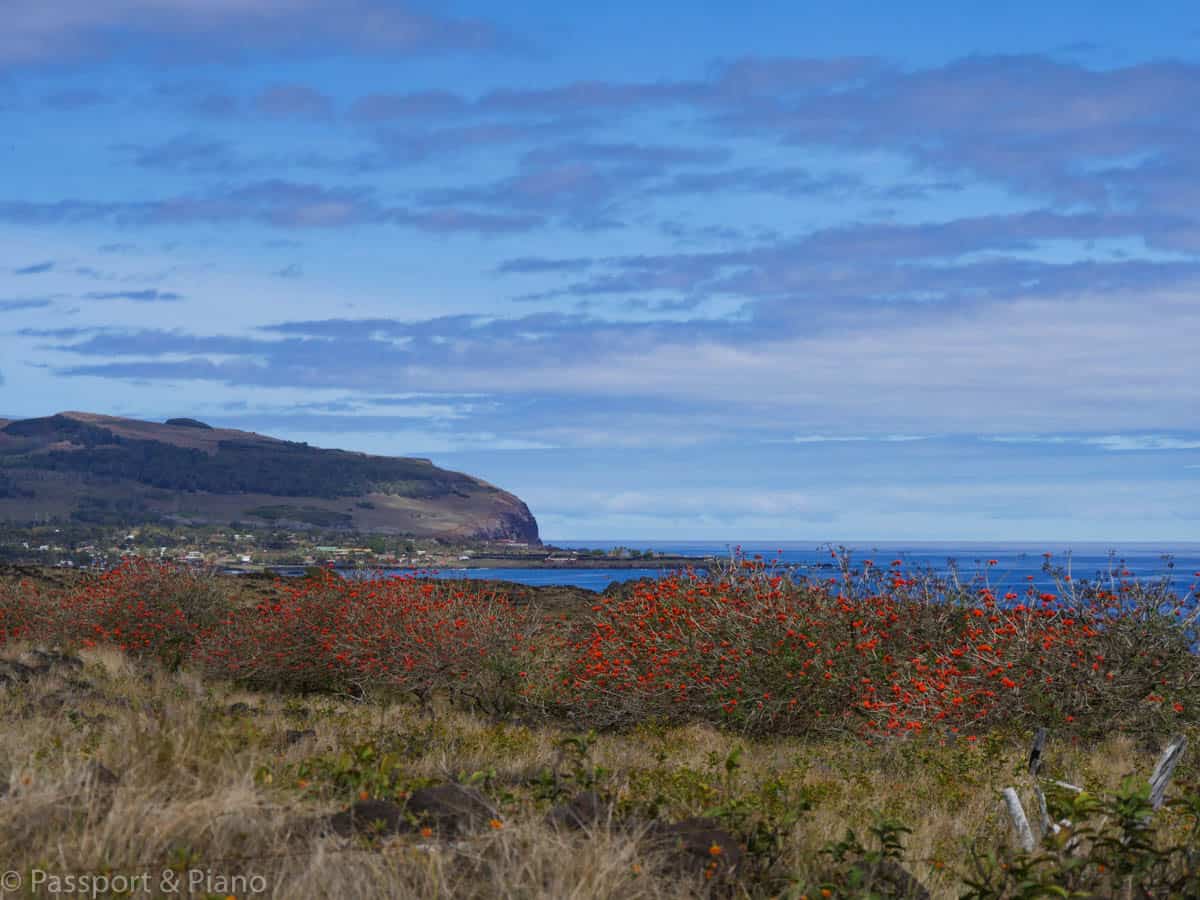
Ana Kakenga Cave
The cave has two fantastic windows which frame the ocean magnificently. The lava flow created the windows, and if you don’t mind confined spaces, it’s worth checking out the view from inside the cave.
The opening is almost hidden; you have to look for a small pile of stones and some tiny steps leading down. It’s best to enter backwards and turn around before you enter the cave.
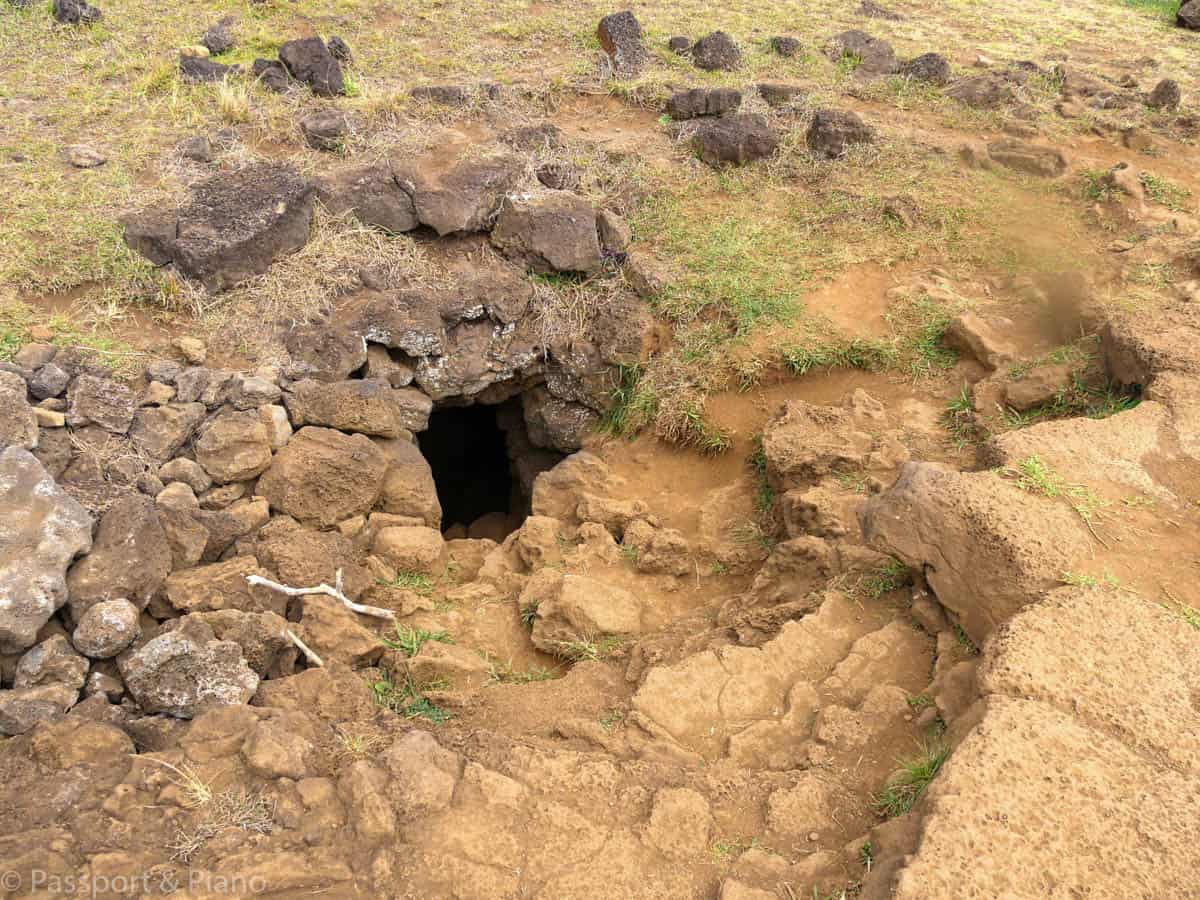
You’ll need a flashlight or torch and it safer to go with someone rather than alone.
The first couple of metres are narrow, but the cave opens up, and from there onwards, you can stand and walk down to both the windows.
It is a sheer drop on the other side, so don’t go too close to the edge. Standing at the perimeter with the waves thundering below you is an exhilarating experience and well worth those first challenging metres upon entry.
Ana Kakenga legend or truth?
One of the Easter Island legends tells of how Ana Kakenga is related to a tragic love story.
A couple who were forbidden to fall in love fled from their punishment and took refuge in the cave. They are said to have remained there until their death or perhaps they jumped into the ocean as no-one has ever found their bodies.
Upon return to Ahu Tahai, you could watch the sunset before heading into town or back to your cabana for dinner. Perhaps try Hetu’Tu, a Chilean restaurant that serves excellent food at the top of the main street.
If you’re looking for an evening activity I would highly recommend a star-gazing adventure. Away from the lights in Hanga Roa, the night sky is spectacular and well worth seeing.
On a good night, the milky way is clearly visible alongside the southern cross and many more amazing patterns.
DAY 4
Start the day by exploring the local sites around Hanga Roa. There is an exciting museum near Ahu Tahai which costs only 2 pesos to enter.
Sebastian Englert Anthropological Museum
The museum closes on Mondays but weekdays its open between 9.30 am to 5.30 pm. At the weekend it closes at 12.30.
The displays are in both Spanish and English, and it currently has around 15,000 artefacts. However, only a small percentage of these are on display.
The white coral Moai eye is one of the highlights. Archaeologists discovered the eye during the restoration of Ahu Nau Nau near Anakena.
There’s also a decent collection of carving tools which the early European visitors used in the 18th Century. The female Moai is also of interest as there are few on the island.
Get a stamp in your passport
Take a visit to the post office near the football ground in town and get your free Easter Island stamp in your passport.
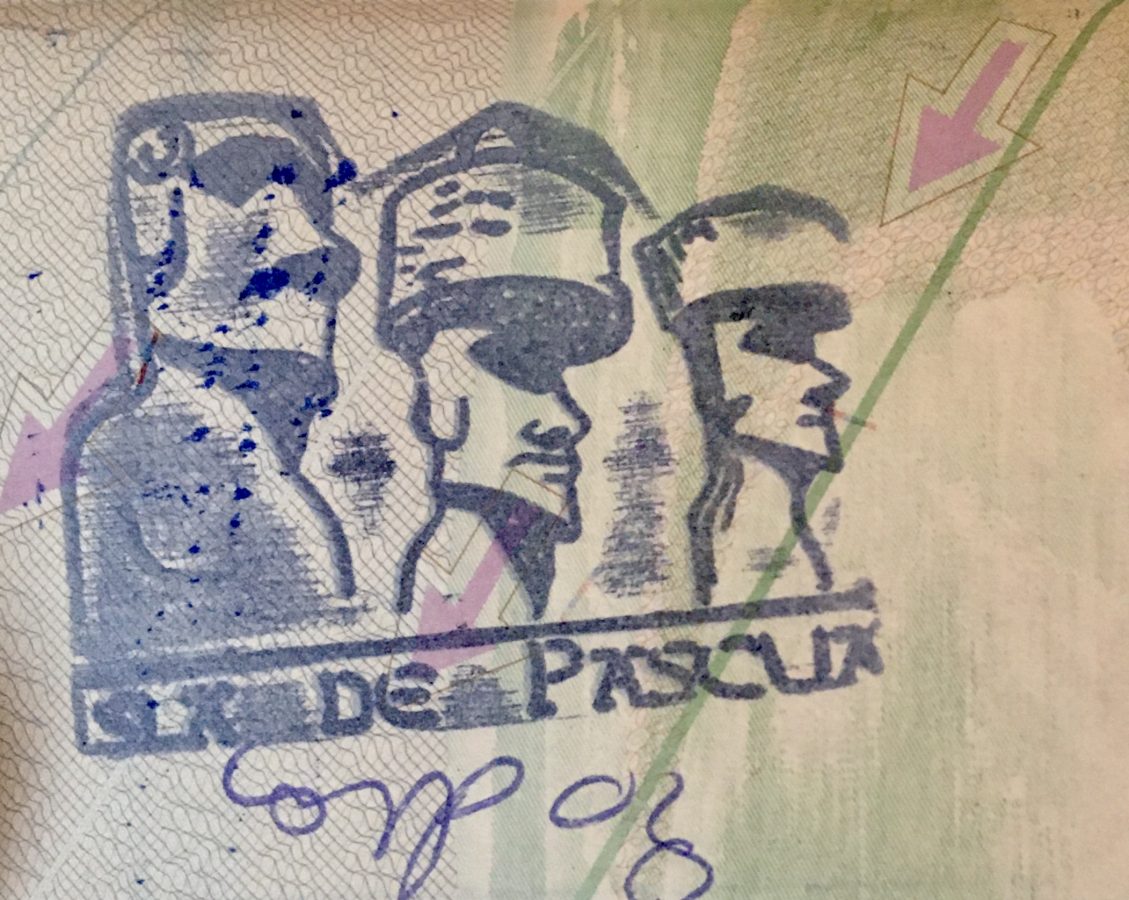
The cemetery
The cemetery is worth a look as the gravestones are both quirky and unique. There are no funeral companies on the island, so residents have to take care of the burial preparations themselves including the building of a coffin.
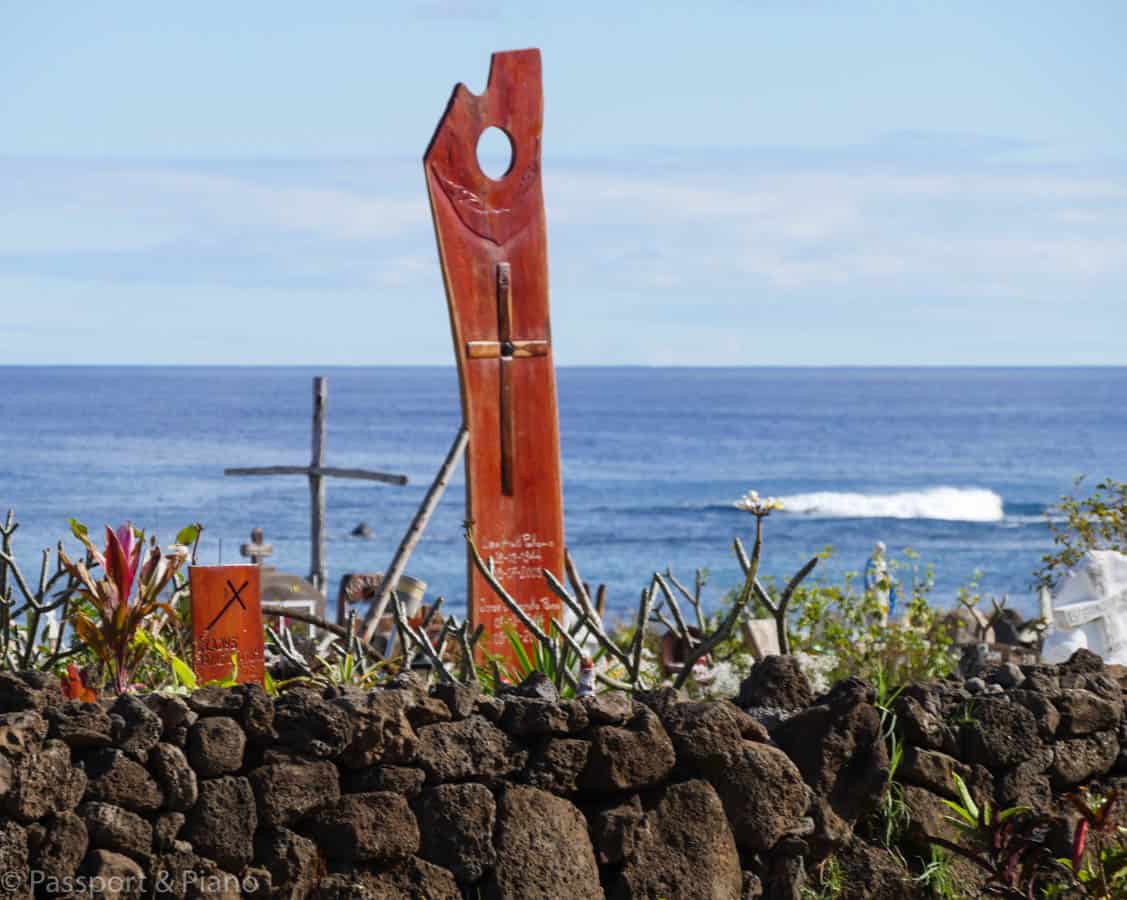
Islanders always bury their relatives with their heads pointing towards the sea. The church of the holy cross has some impressive wooden carvings inside which may be of interest. If you are looking for some traditional souvenirs, the craft market next door is excellent.
Tau Kiani Botanical Garden
One of the latest Easter Island places to visit is the botanical gardens. The area covers 5000 square metres and includes over 12,000 plant varieties from around the world.
Among the plants are various statues made from wood and rock, including of course one of a Moai. There are a couple of small ponds and some exotic Easter Island fauna to admire.
The banana, avocado and guava trees provide structure, and the array of hibiscus flowers is impressive. You’ll also notice how important recycling is to the island in the way that the gardeners have converted toilets and old washing machines into planters.
Hanga Piko
The hidden bay as its known is home to the local fisherman and it’s an exciting place to walk around. The colourful boats give the place charm, and you may see some of the locals with their canoes.

From here, you could book a dive trip to see the Moai that lies beneath the sea. It’s a recreation which set designers made for the film Rapa Nui in 1994.
The water clarity is some of the best in the world with visibility upto 70 metres; however, the underwater world is not as productive as it is in other parts of the pacific.
That said there are some fantastic underwater caves to explore and 26% of the species are endemic to Easter Island so you won’t see them anywhere else in the world.
Boat tour
Taking a boat tour is another option. The most popular trip takes you out to the Motus islets that you can see from Orongo. There’s also a glass-bottom boat ride where you may spot a sea turtle as well as the sunken Moai and a few coral reefs.
In the afternoon you could either go hiking or explore the island on horseback.
A guide to Easter Island hiking
People travelling to Easter Island often don’t take the time to explore some of the best parts which are only accessible on foot.
There are stunning viewpoints to admire, and often you’ll have these all to yourself. There are no restricted areas on the island, and you get a real sense of the remoteness of Easter Island on any of these walks.
Vai Atare
On the way to Rano Kau, you’ll see a yellow sign warning cars not to go beyond this point. If you park up here, there is a trail which heads towards the radio antennae on the right-hand side.
Follow the path, and you’ll reach the crater and the end of the peninsular. The view across the volcano is incredible, more so than from Orongo as the oceanic vistas virtually surround you.
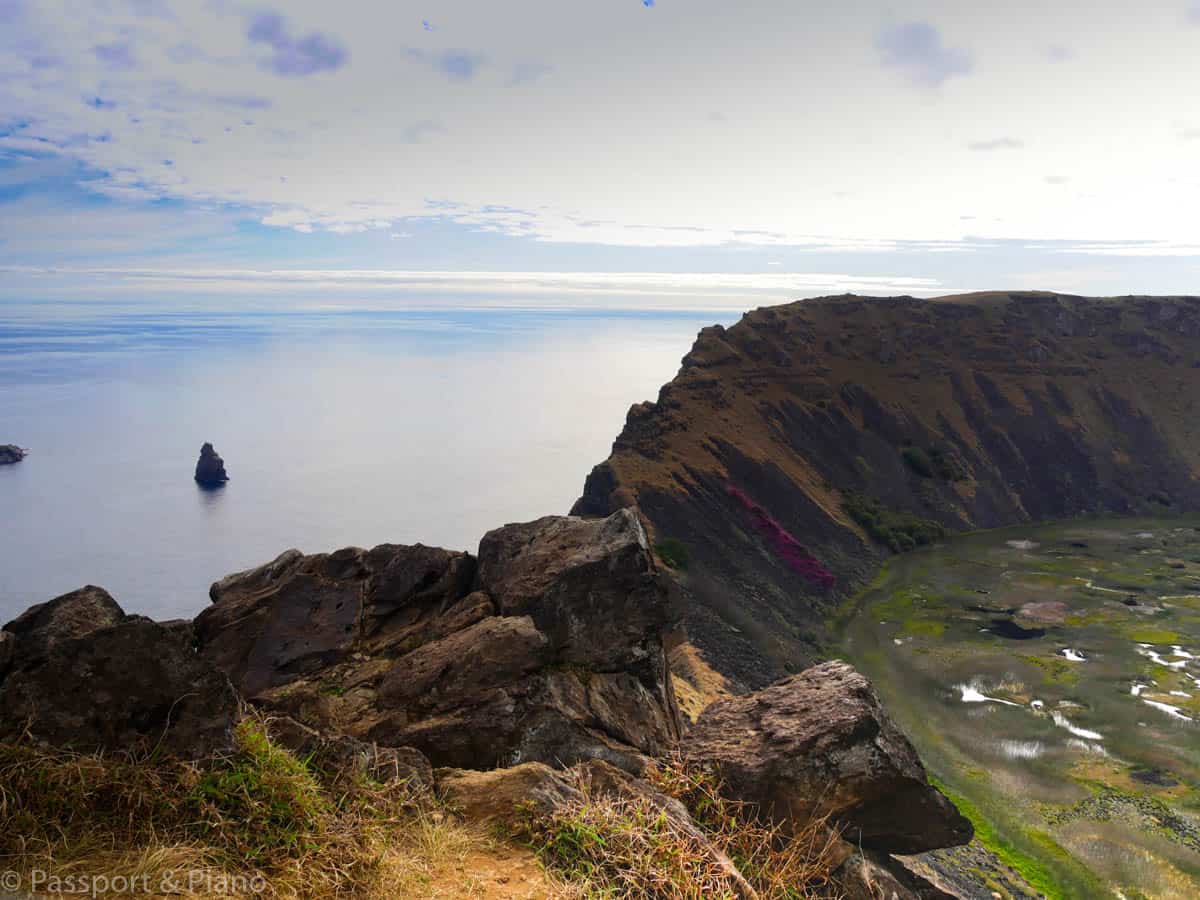
It’s an easy 5km walk which takes a couple of hours to complete. Of course, it could take you longer depending upon the time you spend soaking in the tranquillity at the end of the peninsular.
Ahu Akivi – Terevaka
You can admire the best views on the island without a doubt during this 8km trail. Parts of it are a little challenging, and it takes at least 4 hours to complete, but trust me its worth the effort.
Maunga Terevaka is the highest point on the island at 507 metres above sea level. You get a magnificent 360-degree panoramic view from the top.
The summit is a place where you get a real sense of the remoteness, peace and tranquillity.
You can make this trip on horseback if you prefer; otherwise, the only way is on foot.
A horseback ride to the summit to watch the sunset is also another fantastic way to spend an evening during your stay.
Where is the start
Park your car at Ahu Akivi and walk back 50 metres or so where you’ll see a National Park sign indicating the start of the trail.
There are no signs, but the flattened grass left by the hooves of horses is prominent. If in doubt, keep veering towards the left and uphill.
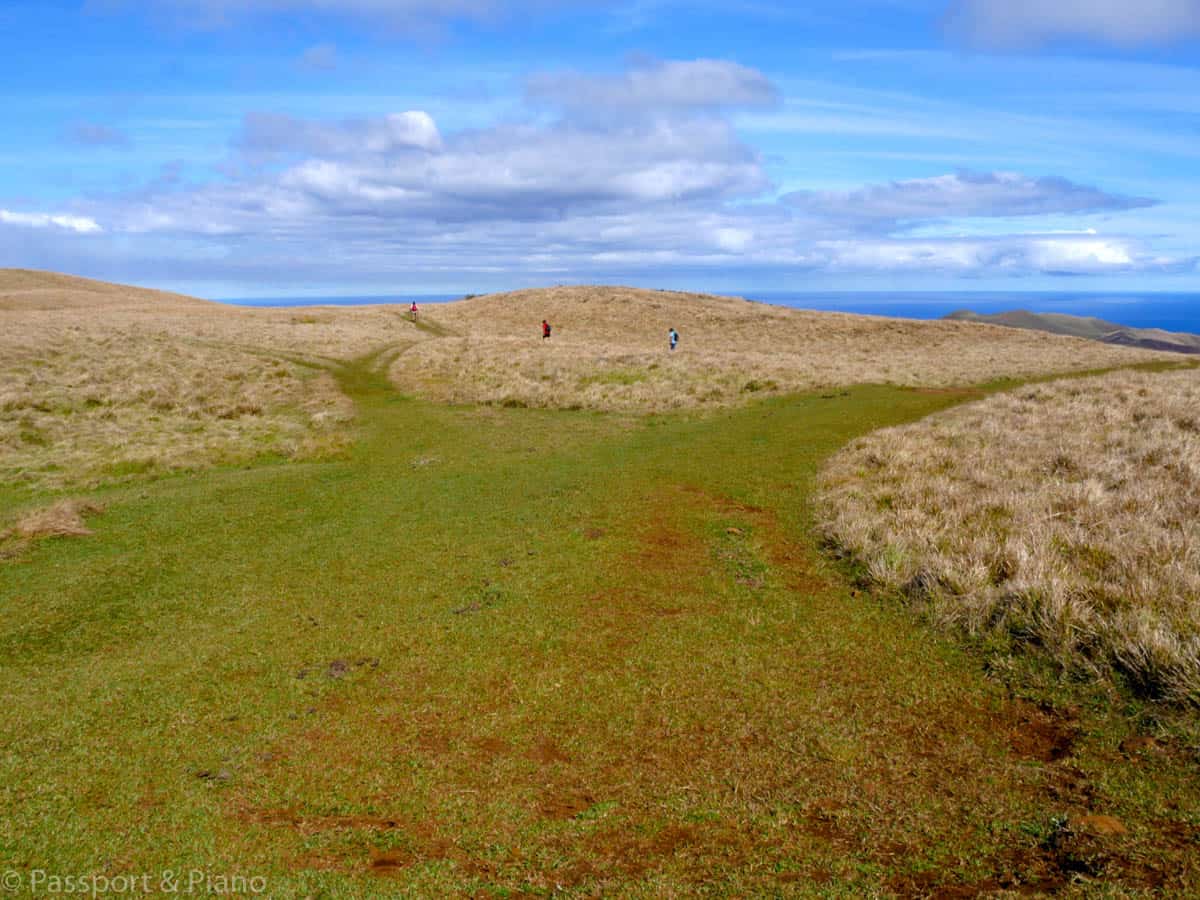
After a couple of kilometres, there’s a forest on the right, and you’ll see a farmhouse ahead. Take the path off to the left towards the coast and begin to climb upwards.
It was an adventure, and I doubt we took the quickest route, but we did reach the summit.
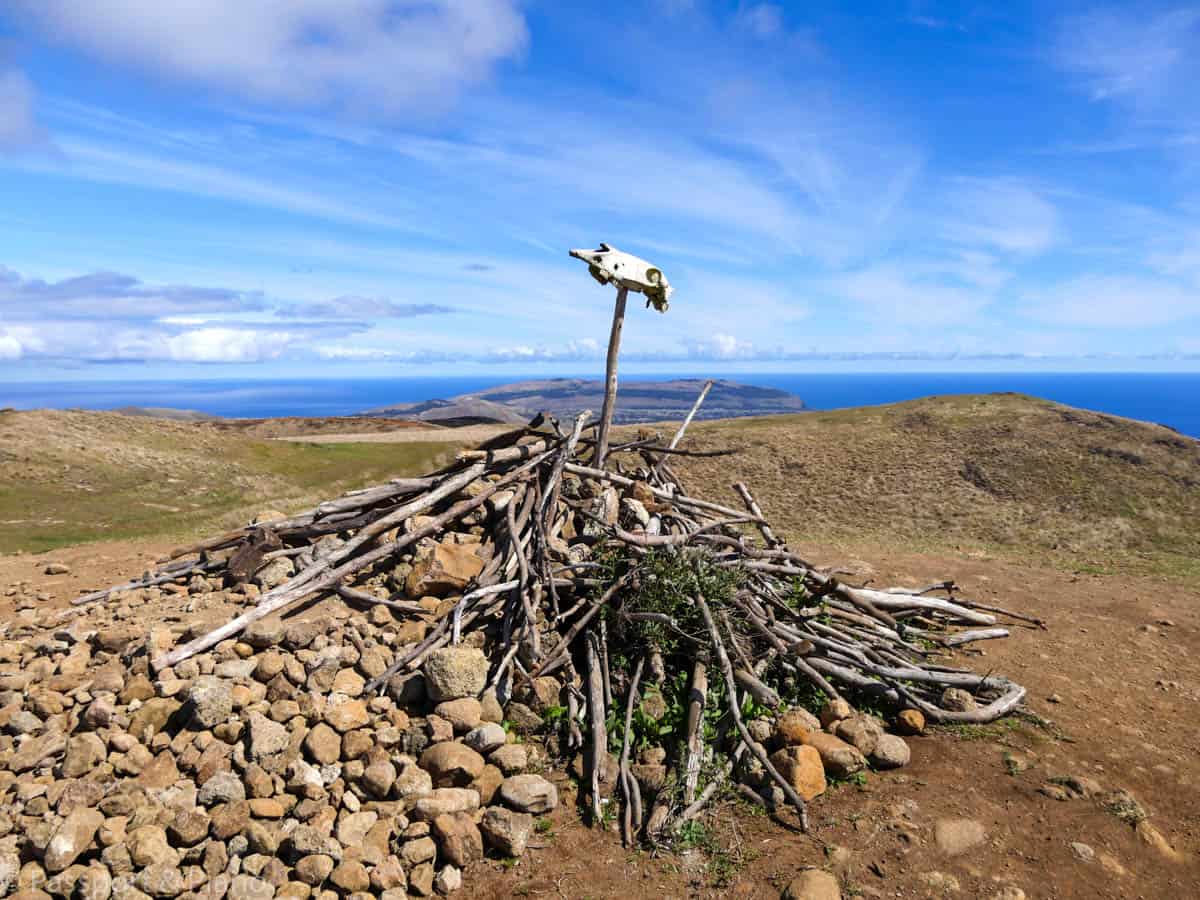
A pile of stones with a skull of a horses head marks the highest point, and from here you can see the whole of the island.
Poike
The volcano area of Poike is probably the least visited place on the island since it used to be out of bounds.
The landscape here is unlike other parts of the island, and there’s some stunning scenery to admire. There are a few hidden archaeological gems, which include Ana O Keke (the virgin’s cave) but you’ll need to hire a guide as they are not easy to find.
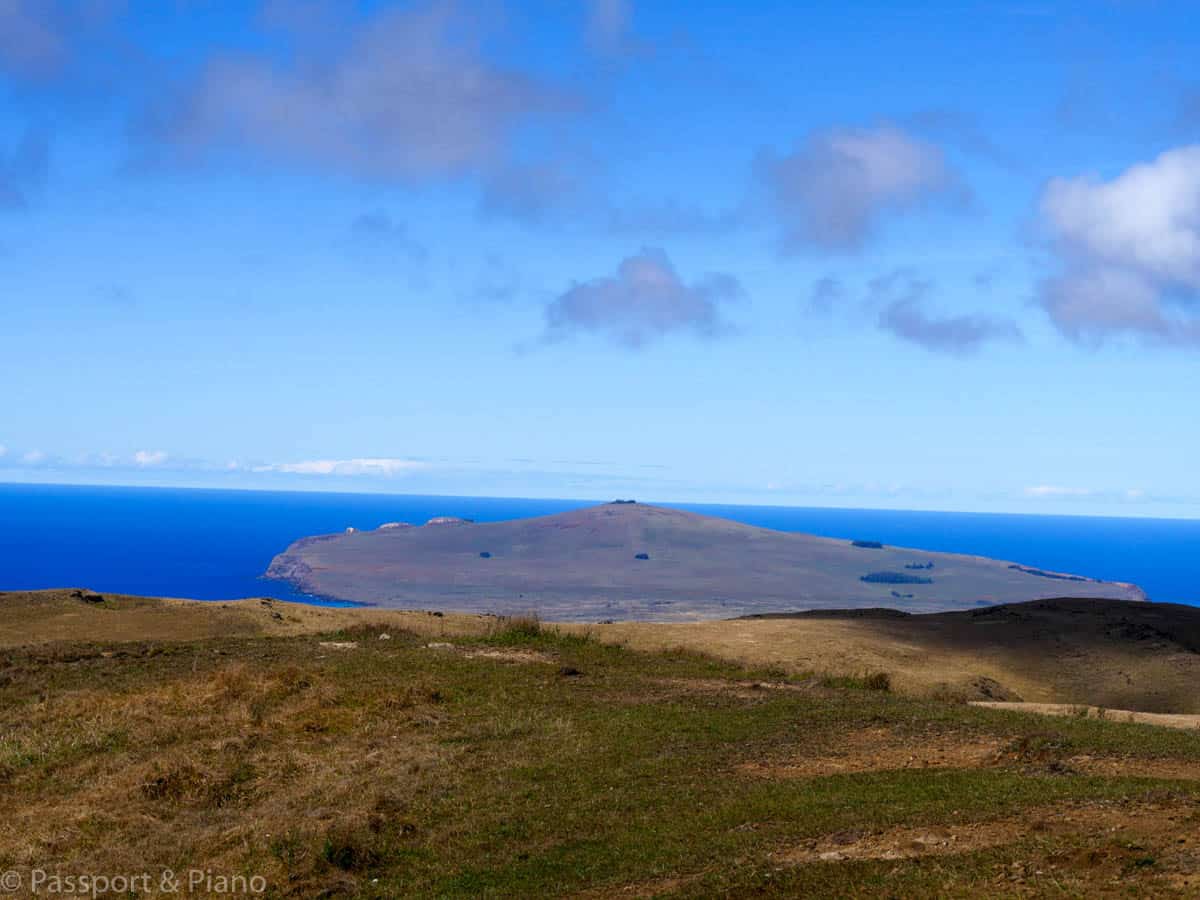
To get to the start of the trail, follow the coast road past Tongariki towards Anakena. Look out for a dirt track on the right past Pu O Hiro. Take the path and continue until you see a small hut where you can leave the car. The 11 km hike takes around 5 hours to complete, and it’s reasonably challenging at times.
North Coast Tahai-Anakena
Taking between 4 and 6 hours to complete in one direction this requires a full day.
To make the most of the hidden sites along the way, it’s also worth hiring a local guide. It’s easier to begin by taking a taxi to Anakena and walking back to Tahai which is close to Hanga Roa.
That way, you don’t have to worry about what time to book a taxi to collect you. There’s little infrastructure along the way, and no roads, hence this is the ultimate way to enjoy the magnificent coastal views and majestic scenery.
You will need to carry enough water for the day and snacks as there is nowhere to purchase anything along the route. From Anakena follow the trail to Hanga Oteo bay.
The path hugs the coastline, so you’re not likely to get lost. You’ll find the remains of several Moai’s along the way, and there are also some caves and petroglyphs.
Day 5
Today you’ll have the morning free to pack before your flight and do some last-minute shopping in Hanga Roa.
Easter Island, how many days?
Due to the remoteness of the island, Easter Island travel itineraries are usually not less than four days.
For me, five days will ensure that you don’t feel rushed. Of course, if you want to explore everything the island has to offer, you may wish to spend longer.
When is the best time to visit Easter Island?
Easter island makes for a great destination all year round, but the warmest months are December through to February.
Rainfall is likely whenever you travel so its advisable to pack a waterproof poncho no matter what month you visit.
The fringe months of October, November, March and April are an excellent time to visit if you want to avoid the crowds.
That said we visited at the start of September and the Easter Island climate was pleasant and above 20 degrees throughout our stay.
How much does it cost to go to Easter Island?
Easter Island is not a cheap destination and its likely to cost you in the region of $2000 US for a 5-day stay including flights.
Of course, you can make savings by not hiring a car for the whole duration of your visit and staying in cheaper accommodation.
Bringing your supplies of food from the mainland will also help keep costs lower.
Where to stay on Easter Island
Most of Easter Island accommodation is in and around the main town Hanga Roa.
Being a small island, your hotel/hostel is likely to be a big part of your Easter Island travel cost. By most standards around the world, rooms are simple, so if you prefer luxury, your options are limited.
As there are only a few Easter Island restaurants, it’s worth considering staying in a cabana where self-catering is an option.
Easter Island Hotels Luxury-Explora Rapa Nui
Explora Rapa Nui is a luxury all-inclusive resort in a stunning location 5 miles from the centre of Hanga Roa.
Included in the package are all your meals, transportation, drinks and excursions around the island. All rooms have gorgeous views either over the garden or ocean and the complex has an outdoor pool to enjoy. Transport is provided to and from the airport and guests highly rate the overall experience.
Self-catering at Hiku o te Ika
Hiku o te Ika is within 30-minute walking distance from the centre of Hanga Roa and Tahai is closeby. The units have beautiful views across the ocean and mountains.
The fully equipped kitchen includes a washing machine and there are free toiletries in the ensuite bathroom. Rosie is a perfect host who is easy to contact via WhatsApp.
Stay in the centre at Inaki Uhi Hotel
In the centre of Hanga Roa, Inaki Uhi hotel offers free breakfast and is within easy walking distance to the towns amenities.
The rooms surround a quiet courtyard and there’s a shared kitchen if you wish to prepare your evening meals. Rooms are simple, but exceptionally clean and all have ensuite bathrooms. The staff are friendly and there is free parking if you wish to hire a car.
What is the best way of getting around Easter Island
Hiring a car is the easiest way to get around the island, but if you are physically fit, you can hire bikes quite cheaply.
Exploring the island on horseback is also another excellent option for some sites. You can also book tours to see the main sites on the island if you do not wish to drive yourself around.
Driving around Easter Island
You can quickly drive around the whole island in one day. The main roads are sealed although there are a few potholes to watch at times. The main thing to watch out for are the wild horses.
Around Hanga Roa, the street signs are marked on the curbs in yellow paint.

If you are driving around the island the Easter Island map locations are easy to find as there are only a few main roads.
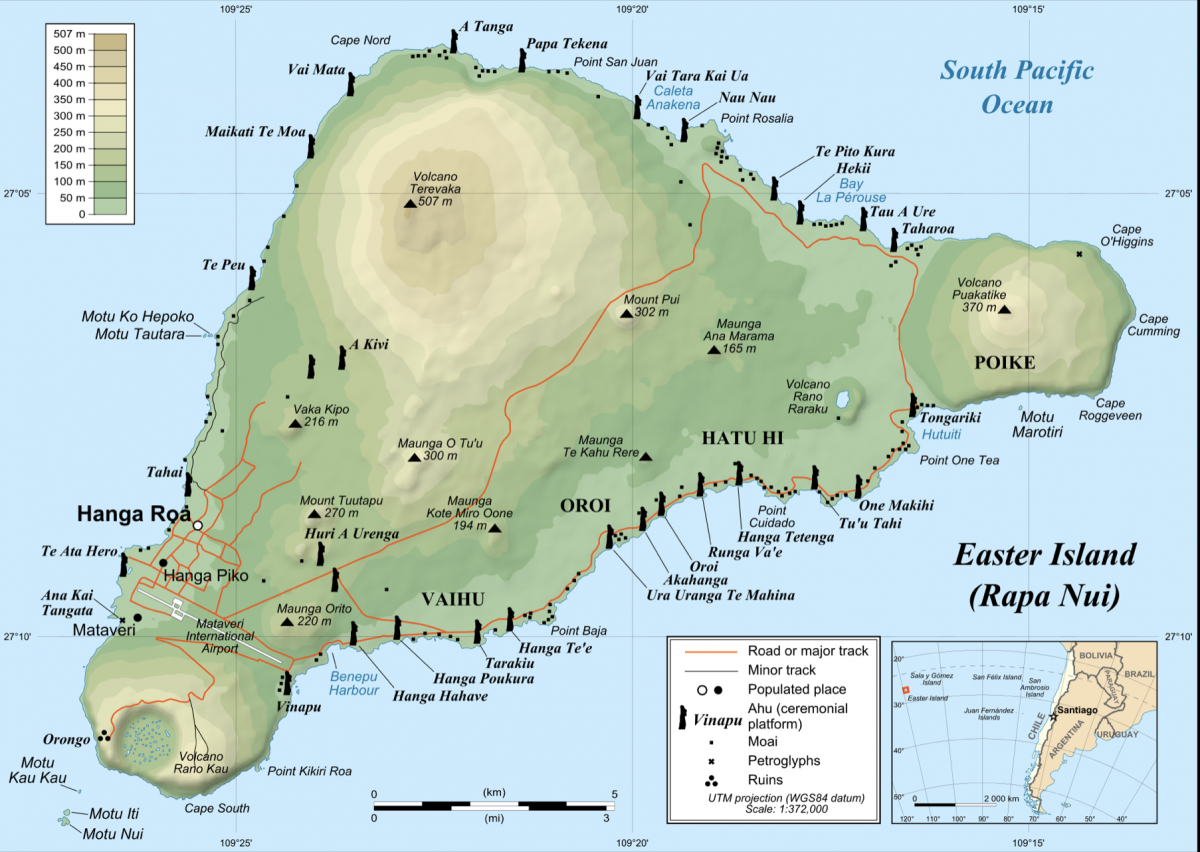
Easter Island Horses
The island has over 3000 horses which do have owners, but as there is nowhere for them to escape to, they are left to roam.
Most are not broken in, and they can cause severe accidents if they dart across you in the road.
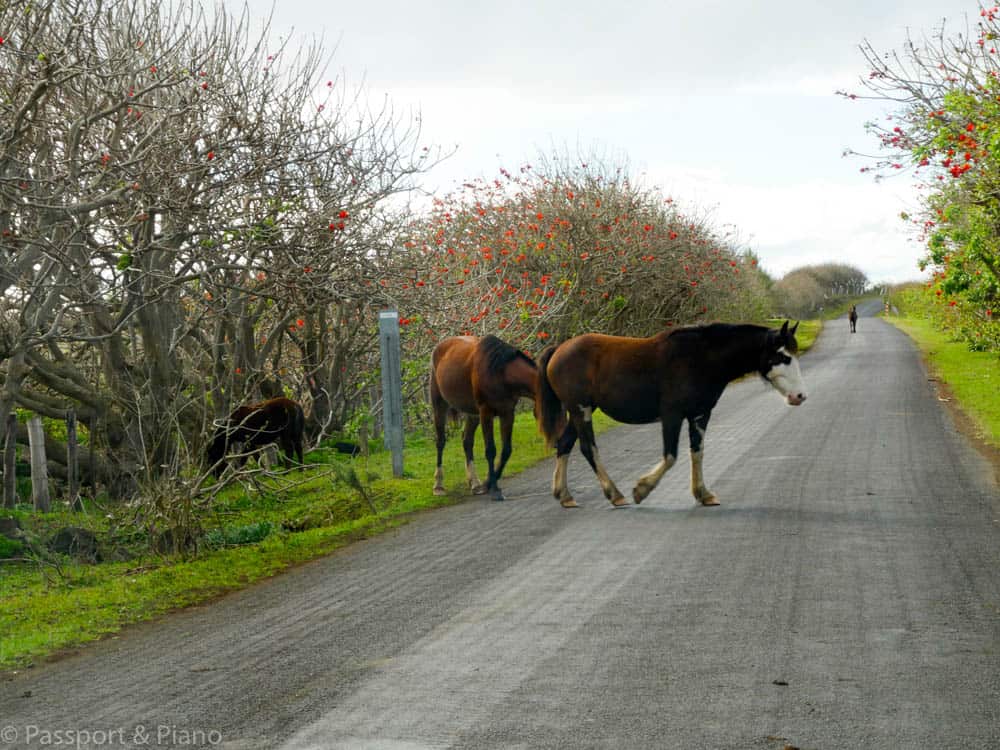
For this reason, speed limits around the island are slow and usually kept lower than 50 km. Around Hanga Roa and the airport, the speed limit is 30 km per hour.
The road signs are clear, and all the main sites have free car parking. Street parking is available in town, and the petrol station is down the road from the airport.
Most cars available for rental are old Suzuki jeeps which will take you back to the 1980s. We did have to get help jump-starting ours on the first day as I forgot to turn the lights off manually.
There is no insurance available on the island, so if you bump the car, you will have to pay for any damage. I was initially worried about this, but it was okay. There’s very little traffic on the island.
Drive carefully and take your time. The locals don’t rush so neither should you if in doubt pull over and let the person behind you pass.
National Park Easter Island information
When you arrive on Easter Island, you have to purchase a National Park ticket. These cost $80, and it’s advisable to carry it throughout your stay. You often have to show the card to gain access to the archaeological sites.
All sites except for Tongariki open at 9.30 am. Tongariki opens at sunrise as this is the most popular time that people visit.
You can only visit Orongo Village and the quarry Rano Raraku once. Still, you’re free to visit the other sites as many times as you like.
Your ticket is valid for ten days, and the authorities are strict. If you lose it, you will have to return to the airport to buy a new one.
National Park Rules
Don’t be tempted to break any of the National Park rules as there are hefty penalties. The rules are there to protect and preserve the Moai for generations to come.
Do not touch any archaeological remains.
Do not stand on the platforms or ahus.
No driving outside of the marked trails.
No camping is allowed within the National Park.
Respect all signs and markings on the sites.
Easter Island Language
Locals tend to be bilingual speaking both Spanish and the native language Rapa Nui. You’ll also find that they can speak reasonably good English. Most restaurants have English menus, and all the archaeological sites have English translations.
Easter Island Currency
The currency throughout the island is the Chilean Peso. There are several ATMs on the island, and the bank will exchange money.
The best currency to trade-in is US dollars, but you’ll get a much better rate if you change them on the mainland. Many of the restaurants and hotels do take a credit card.
Still, it’s always best to have some cash as the internet connection is not that reliable. Hence, the card machines don’t always work.
Medical insurance
Given the remoteness of Easter Island, it is essential to travel with full medical coverage. Make sure it includes evacuation costs as you would have to transfer to the mainland for treatment of any serious illness.
Booking through a reputable company such as World Nomads will give you peace of mind and ensure that you enjoy your Easter Island adventure.
Easter Island Package Tour
If you don’t want to organise your trip to Easter Island by yourself, why not consider taking a tour. TourRadar is a great place to start when looking for an organised trip as it includes many options from most of the big travel companies.
Passport and Piano is a participant in the Amazon Services LLC Associates Program, an affiliate advertising program designed to provide a means for sites to earn advertising fees by advertising and linking to amazon.com, amazon.co.uk, amazon.ca. Amazon and the Amazon logo are trademarks of Amazon.com, Inc. or its affiliates.

